#general contractor virginia
Explore tagged Tumblr posts
Text
G&A General Contractors, LLC. is your leading Northern Virginia Roofing Company, located in McLean, Virginia. We provide you with a free instant roof estimate and specialize in various roofing systems such as Designer, Luxury, and Specialty. With our extensive range of services, we are dedicated to serving you and becoming your trusted roofer.
#General Contractor Fairfax VA#General contractor Reston VA#General Contractors Alexandria VA#Kitchen remodeling Northern Virginia#Home remodeling McLean#Virginia#Remodeling contractor Clifton VA
0 notes
Text
General Contractor Northern Virginia
Bierstone LLC, a leading general contractor serving Northern Virginia, is your go-to choice for all construction needs. Our experienced team specializes in residential projects, delivering superior craftsmanship, personalized solutions, and timely execution. For more details visit us at https://bierstonellc.blogspot.com/2023/06/transform-your-home-with-professional.html
0 notes
Text
Trump administration disbands taskforce targeting Russian oligarchs
A memo from the attorney general, Pam Bondi, issued during a wave of orders on her first day in office but not previously reported, said the effort, known as Task Force KleptoCapture, will end as part of a shift in focus and funding to combating drug cartels and international gangs. The taskforce brought indictments against the aluminum magnate Oleg Deripaska and TV tycoon Konstantin Malofeyev for alleged sanctions busting, and seized yachts belonging to the sanctioned oligarchs Suleiman Kerimov and Viktor Vekselberg. It also secured a guilty plea against a US lawyer who made $3.8m in payments to maintain properties owned by Vekselberg.
Trump Green-Lights Bribery and Corruption With New Executive Order
President Donald Trump has instructed Attorney General Pam Bondi to pause prosecutions of companies that bribe foreign government officials to win business. The Foreign Corrupt Practices Act has been “stretched beyond proper bounds and abused in a manner that harms the interests of the United States,” hurting American competitiveness, Trump wrote in an executive order signed Monday. [...] The order’s legality was not immediately clear. Generally, the Constitution requires the president to “take care that the laws” passed by Congress “be faithfully executed.” Presidents do have some enforcement discretion, but they cannot override laws, according to the ACLU. Major companies such as Goldman Sachs, Glencore and Walmart have all come under FCPA scrutiny, according to Reuters.
///
"It's going to mean a lot more business for America," Trump told reporters while signing the order in the Oval Office on Monday. Trump wanted to strike down FCPA during his first term in office. He has called it a "horrible law" and said "the world is laughing at us" for enforcing it. Anti-corruption watchdog Transparency International said FCPA made the United States a leader in addressing global corruption. (x)
///
“It sounds good on paper, but in practicality, it's a disaster,” Trump said. “It means that if an American goes over to a foreign country and starts doing business over there, legally, legitimately or otherwise, it's almost a guaranteed investigation indictment, and nobody wants to do business with the Americans because of it.” [...] Gary Kalman, executive director of Transparency International U.S., said Trump’s order “diminishes—and could pave the way for completely eliminating—the crown jewel in the U.S.’s fight against global corruption.” [...] In one of its most significant victories, the Justice Department announced Oct. 16, three weeks before Trump’s election victory, that mega-defense contractor Raytheon Company of Virginia would pay over $950 million to settle foreign bribery and related charges in a scheme to help foreign governments purchase PATRIOT missile systems and operate and maintain a radar system. In one of the schemes, Raytheon engaged in a campaign from 2012 and 2016 “to bribe a high-level official” within the Qatar government’s military “in order to assist Raytheon in obtaining and retaining business” from it, the DOJ said, citing admissions and court documents filed in the Eastern District of New York. [...] Raytheon’s “criminal schemes to defraud the U.S. government in connection with” the contracts “erodes public trust and harms the DOD, businesses that play by the rules, and American taxpayers,” Deputy Assistant Attorney General Kevin Driscoll of the Justice Department’s Criminal Division also said at the time. (x)
this is the most relentlessly pro-corruption administration in american history. the guiding animus seems to be how much corruption can we do, how can we help others get away with corruption, how can we halt justice, etc
69 notes
·
View notes
Text
Article: 'EA’s BioWare will lay off 50 and cut ties with unionized Keywords playtesting group'
[BioWare Blog post for reference]
Excerpts:
"The layoffs are a blow to morale at the studio and have made the environment difficult, said Gary Mckay, general manager of the developer, in a statement to employees today. He said EA is trying to make BioWare into a more agile and more focused studio. EA has an estimated 12,000 to 13,000 employees, and BioWare had perhaps 250 people. The moves come with a couple of related or perhaps coincidental events. A spokesperson for EA said that the company was unable to come to an agreement with a part of Keywords, a big game services firm, that provides playtesting services. In June 2022, this small part of Keywords had a group of contractors who voted to unionize. EA said it was unable to create a new contract and so will let that current one expire on September 27. It’s not clear what will happen to the contractors without the EA contract, but it’s fair to guess that some jobs will likely be lost over at Keywords unless they find other work. An industry source said EA has renewed work orders with Keywords Studios since their employees voted to unionize in June 2022. But the source added that, in this instance, the two companies simply couldn’t agree to terms. The Keywords contract requirements exceeded what EA/BioWare needed given the change in development approach at the studio. The layoff also comes about three months after EA moved production of its massively multiplayer online game, Star Wars: The Old Republic, to a third-party publisher, Broadsword, in Reston, Virginia. The game debuted way back in 2011 and has entered maintenance mode. Broadsword has also taken over games like Ultima Online and Dark Age of Camelot so players can keep playing them. McKay’s leadership will not be affected. Michael Gamble, who recently returned to BioWare, serves as head of the Mass Effect team, and pre-production continues on the next Mass Effect game. Corinne Busche and John Epler, two leaders on Dragon Age, also continue in their roles. Andrew Wilson, CEO of EA, announced back in March that the company would cut about 6% of its total workforce, and these cutbacks are related to that move. EA has not said when Dragon Age: Dreadwolf will ship."
[source and full article]
#dragon age: dreadwolf#dragon age 4#the dread wolf rises#da4#dragon age#bioware#mass effect#mass effect 5#video games#long post#longpost#sw:tor
614 notes
·
View notes
Text
At the 2023 Defcon hacker conference in Las Vegas, prominent AI tech companies partnered with algorithmic integrity and transparency groups to sic thousands of attendees on generative AI platforms and find weaknesses in these critical systems. This “red-teaming” exercise, which also had support from the US government, took a step in opening these increasingly influential yet opaque systems to scrutiny. Now, the ethical AI and algorithmic assessment nonprofit Humane Intelligence is taking this model one step further. On Wednesday, the group announced a call for participation with the US National Institute of Standards and Technology, inviting any US resident to participate in the qualifying round of a nationwide red-teaming effort to evaluate AI office productivity software.
The qualifier will take place online and is open to both developers and anyone in the general public as part of NIST's AI challenges, known as Assessing Risks and Impacts of AI, or ARIA. Participants who pass through the qualifying round will take part in an in-person red-teaming event at the end of October at the Conference on Applied Machine Learning in Information Security (CAMLIS) in Virginia. The goal is to expand capabilities for conducting rigorous testing of the security, resilience, and ethics of generative AI technologies.
“The average person utilizing one of these models doesn’t really have the ability to determine whether or not the model is fit for purpose,” says Theo Skeadas, chief of staff at Humane Intelligence. “So we want to democratize the ability to conduct evaluations and make sure everyone using these models can assess for themselves whether or not the model is meeting their needs.”
The final event at CAMLIS will split the participants into a red team trying to attack the AI systems and a blue team working on defense. Participants will use the AI 600-1 profile, part of NIST's AI risk management framework, as a rubric for measuring whether the red team is able to produce outcomes that violate the systems' expected behavior.
“NIST's ARIA is drawing on structured user feedback to understand real-world applications of AI models,” says Humane Intelligence founder Rumman Chowdhury, who is also a contractor in NIST's Office of Emerging Technologies and a member of the US Department of Homeland Security AI safety and security board. “The ARIA team is mostly experts on sociotechnical test and evaluation, and [is] using that background as a way of evolving the field toward rigorous scientific evaluation of generative AI.”
Chowdhury and Skeadas say the NIST partnership is just one of a series of AI red team collaborations that Humane Intelligence will announce in the coming weeks with US government agencies, international governments, and NGOs. The effort aims to make it much more common for the companies and organizations that develop what are now black-box algorithms to offer transparency and accountability through mechanisms like “bias bounty challenges,” where individuals can be rewarded for finding problems and inequities in AI models.
“The community should be broader than programmers,” Skeadas says. “Policymakers, journalists, civil society, and nontechnical people should all be involved in the process of testing and evaluating of these systems. And we need to make sure that less represented groups like individuals who speak minority languages or are from nonmajority cultures and perspectives are able to participate in this process.”
81 notes
·
View notes
Text

Recent Acquisition - Ephemera Collection
Specialists in Remodeling, Repairing and Reconditioning. C.W. Spittle, General Contractor and Builder. 1312 East Cary St., Richmond 19, Virginia
20 notes
·
View notes
Text
When the World Fades
Previous Chapter - Masterlist - Next Chapter


»»-------¤-------««
I sat in the kitchen area at the end of the hallway, sitting alone as I recalled the last several hours, Valeria's words seeping into my mind like a bad infection. "You tell me. You're the contractor, no?"
That question replayed in my mind like a broken record, and I possibly was overthinking the question, but I knew better than to brush it off due to my gut instinct telling me to look into it more. Why did Valeria call him a contractor? Because contractors plan and execute ideas. Why would she call him a contractor if she didn't know something?
Immediately, I pulled out my phone to check for new notifications, a sigh of relief leaving me when I got an email notification from Kate, stating that she was now okay and was able to confirm that the guidance systems for the missiles were originally in Spain and were now on the missiles. I had my confirmation with something to branch off of for more research.
I took another drag from my vape pen, exhaling through my nose before I stood to my feet, making my way towards my room before locking myself inside. I was so fucking tired now that my adrenaline was wearing off, a faint soreness invading my limbs after I sat down at the small desk, opening my laptop and notepad to begin my research, the small piece of paper I had written on during Hassan's interrogation pressed beneath a paperclip on the first page of my notebook.

I was going to do more research, remembering how Kate mentioned why she was tasking me on this in the first place.
Starting off, I did a background check on both Graves and Shepherd, seeing that there wasn't anything to use for potential evidence.
That was, until I started digging a little deeper...

0511. That was the number on the missile Soap told me about when his team found the first missile in Al Mazrah.
"What was your intention on sending missiles to my land?" I remembered Hassan asking Graves the night of his interrogation, the same question written on my scrap piece of paper.

I began to start my research with the number on the missile, finding that I was able to track it by seeing its history of being assembled in Alabama at the MFC (Lockhead Martin Missiles and Fire Control), which is where most American missiles are manufactured, seeing that it was then transported to Arlington, Virginia, coincidentally along with two other missiles out of Texas, which is also where Graves called home. After that, I was able to track a shipment from Virginia all the way to Urzikstan without the proper stops and checkpoints required for transporting missiles overseas. This was off the books.
A Black Bag Operation.
Conducted by Commander Graves and approved by General Shepherd.
Oh, I've got you now, motherfucker.
I quickly dialed Kate's phone from my burner phone, a smart move considering anything could be tracked nowadays. "Kate, how are you?"
She sighed, "Better than how I was. What've you got for me?"
"I started with the number on the missile Sergeant MacTavish found with the team in Al Mazrah. I traced it back from Alabama where it was made and sent to Virginia before it was transported out overseas. Never once made a mandatory stop at checkpoints."
"Any names?"
"Yeah. Conducted by Graves and approved by Shepherd."
"I'm going to do some digging. I'm due back to the Pentagon tomorrow morning."
"Okay. We also found and interrogated a sicaria posing as El Sin Nombre. I'm going to link up with Graves and see what he was able to find out all while gathering intel on my own."
"Okay, Kiera. Report back to me with what you can find out."
"I will. Stay safe out there."
"Always. You too."
I locked my laptop and put it away along with my notebook before deciding to take a shower, eager to rid my skin of the thin sheen of sweat that consumed the top layer of my skin.
Relieved and relaxed, I left my hair down over my shoulders after I had changed into a new set of attire that were designed to keep me cooler in the Mexican climate, strapping a thigh holster against me just in case.
Until we gathered additional intel, the Task Force, me, and Mexican Special Forces were on rest for the remainder of the day. Most took advantage by taking longer showers, having fun on utility vehicles to explore the desert, or engaging in P.T. As for me, I found myself on top of a hill that was mainly used for a lookout, but I found myself enjoying the isolation and take advantage by listening to my favorite playlist, cracking open a can of Dr. Pepper, and taking a few drags from my vape pen as I gazed over the landscape Mexico had to offer. The live version of Kate McCannon by Colter Wall played lowly from my phone's playlist, drowning out the silence that surrounded me.
The strong chords and low voice reminded me of Wyoming, and I wished I was home – far better than where I currently was.
"Interesting music taste." A voice startled me, nearly making me jump out of my skin. Ghost – standing there as if I had taken his lookout spot.
"It's real music if that's what you're asking." I smirked.
"You say so," He shrugged. "Never heard it."
"Not surprised. Didn't think music like this would exist in the U.K. You're missing out," I teased. "You look like you're here to take a post. I'll get out of your way—"
"No need. I usually come up here to do the same thing you're doing," He cut me off. "Care for some company?"
"You didn't seem the type to like company."
"It usually doesn't bother me. Unless it's Soap, then I like being alone." He shook his head, taking a seat close by before removing his balaclava from his head, running his fingers through his hair with a deep sigh.
This man was beautiful, and I wondered why he chose to conceal his identity. He had deep brown eyes with dark blonde hair and light stubble with a build that I couldn't help but get butterflies over. He was a prime example of a military man, and my stomach twisted into a knot when I realized that his sleeve concealed an arm full of tattoos on his left arm.
I couldn't help but take another hit from my vape pen when I watched him roll up the sleeves of his ACU jacket, desperate to rid my mind of realization that this man was insanely attractive, and I knew I would have no chance.
"How'd he acquire a callsign like that?" I asked him.
"I really don't know. To be honest, I'm afraid to ask."
I chuckled, "why's that?"
"You know what they say about don't drop the soap. He strikes me as the one who has, and it just stuck."
"Great, now I can't look at him another way even if he does eventually tell me why he chose Soap as his callsign." I shook my head, taking another drag before I offered it to him. "Want a hit?"
He shook his head, "I'm alright. I don't smoke unless I'm anxious."
"If you're anxious, it must be serious, because I've been anxious ever since I've been here." I giggled.
"You'd be surprised," He huffed. "Can I ask you something?"
"Sure."
"What you said about Graves a couple days ago. Why'd you say it?" He asked, his tone of blunt curiosity, which surprised me. I haven't known this man long, but I did know that he was a reserved, observant type, and if something intrigued him enough to ask a question that he knew he probably shouldn't, he was genuinely curious.
"I'm afraid it's classified information, Lieutenant."
"Okay."
We caught each other's gaze, looking into the other's eyes for a few seconds, seeing that he was genuinely wondering what I was doing here if I wasn't a part of the Task Force or Special Forces. He knew I had worked alongside his Captain before, yet we had never met prior to our assignment. He knew I worked closely with Kate, and he seemed to be trying to put together the pieces as to who I was. Not for intel, but his own curiosity, perhaps interest. I felt like I could trust him, but I've learned a long time ago to not trust anyone fully, especially a man, and that was of no fault of his own, but it's unfortunate that a few bad encounters I've had with men aside from enemy forces had ruined that for me.
"I'm here for the same reason you are, following orders."
"Fair enough."
A moment of silence fell between us, and I was oblivious to how much I relaxed while in his presence. He was mysterious and intimidating, yet I felt the safest when around him. I felt the world seem to fade around me when I was with him, and I knew that I was thinking too far and giddy from the excitement of having an attraction to someone.
I couldn't help but hum along to the next song that played from my playlist, Zach Bryan's song Dawns featuring Maggie Rogers. "It just dawned on me, life is as fleeting as the passin' dawn..." I thought that my humming was low enough to keep him from hearing the words I was singing along to, but I guess I wasn't as oblivious as I thought.
"I take it you like to sing, yeah?" He asked.
I couldn't help but smile. It was a genuine smile that appeared very briefly throughout my life – a smile that was innocent and vulnerable when all I was used to was being dominant and intimidating. "I do, but I'm not a professional or anything. Just a talent that I occupy my time with."
"Any favorites?"
"Any song I like is a favorite," I chuckled. "I mumble just about anything."
"You've got to have a favorite that you can't help but sing every time you hear it, no matter where you are."
"Eh, you'll think it's silly."
"Try me."
"You know that movie with Bradley Cooper and Lady Gaga?"
"Who? I don't really watch a lot of movies, love. Don't have the time."
"Do you even know who they are?"
"No."
"Well, they're in a movie together called A Star is Born. There's a song in that movie called Always Remember Us This Way, and I've loved it ever since I heard it. It's one of my favorite movies."
"I'm assuming it's a love story type of movie?" He guessed.
"Yeah, not surprising, huh?" I laughed. "I've always loved that song, but it was catchy with no meaning behind it for me. Never had a reason to sing it and actually enjoy it."
"Why?"
I never expected to hear him ask that question when I figured he'd just drop it and not pry, so I was caught off guard and surprised that he wanted to know.
"Stupid reason. Had a man who I thought loved me, but I wasn't good enough, I guess. I caught him cheating on me, and when I confronted him about it, he got defensive and tried to gaslight me into making me think I was crazy."
"You shouldn't let that affect what you love to do."
"Easier said than done, Lieutenant—"
"Simon." He corrected, his tone sounding of regret after correcting me. I saw how tense he was, letting down a wall of his own because he wanted me to know. I showed him a smile of vulnerability, something that I rarely ever did because of my own trauma and past experiences as I didn't want to give him a chance to take advantage of me, yet he gave me his name when it was obvious he went by Ghost for a reason.
He was being vulnerable with me, even if it was just an ounce of it.
"Simon." I repeated, a faint smile spreading on my face.
"Simon Riley." He choked out. Another ounce of vulnerability. I finally knew this man's name, sharing the same information that possibly very few people knew.
"Kiera Dutton."
"Strong name." He complimented, unaware that I was able to realize that he forced out the compliment as it was something new and rare for him, obvious that it wasn't common for him to express a compliment to anyone besides saying "good work" or "nice shot."
"Thank you. You need a strong name for living in Wyoming," I giggled, easing the tension before looking down at my watch. "Well, I gotta get back to the base. I asked Alejandro to sit down with me for a briefing before turning in for the night." As I went to get up, a rock that had shifted under my foot caused me to lose my balance, and Simon didn't hesitate to reach his arm out and prevent me from falling on my back, but he was a second too late. I laughed as I embraced my embarrassment, accepting his offer of helping me to my feet to keep me from falling again.
"Clumsy today, yeah?" He teased me, keeping a firm grip on my bicep until I was stable on my own two feet.
"I sat for too long, and my leg is still hurting from that terrifying cliff jump, ya know. My leg fell asleep and did me dirty."
"That wasn't even a far fall."
"I beg to differ!" I scoffed. "That was a first-class ticket straight to hell if I had to name it!"
"You must've not jumped out of planes before, then."
"Believe it or not, I have. I felt safer because I had a parachute, but when we jumped off of that cliff? I had to rely on positivity and luck not to hit a jagged rock."
"Fair enough."
"Here," I said, handing him my iPod I kept as a spare just in case I broke my phone. "Listen to all of my good music that you're missing out on. You won't regret it." I giggled.
"I might."
"You never know. Might find a song you like."
»»-------¤-------««

For the rest of the day, Kiera and I haven't seen each other since we split off from the lookout post. I got a good look at her face in the golden hour of a Mexican sunset, and she didn't fail to make my breath hitch. She was so bloody gorgeous, and only having the interaction from earlier and not being close to her since we separated, it was a bloody tease.
I had gone off to bed early, taking the advantage of a day off to get much-needed sleep, but my body was against me as I suffered through usual insomnia. Kiera's iPod was sitting next to me on my cot, yet I hadn't even listened to any of her music that she suggested. In fact, I didn't even touch it because I didn't want to drain her battery, but perhaps she had a song on her music list that could possibly help me fall asleep. I never had a particular taste in music, listening to a random song on the radio while I was back home in Manchester.
Deciding to give this iPod a try, I held it above my head, pressing the button and seeing that her background wallpaper was a family photo – all on horseback with a rugged mountain backdrop behind them. She must have a perfect life.
I knew I shouldn't have tapped on her photo album, not wanting to invade her privacy, but I figured it was harmless curiosity as well as keeping my embarrassment of having to ask her more questions about her personal life. I figured that I could get to know her better this way. I was horrible with communication and self-esteem, and I knew that trait was what ruined my former relationships, my most recent being a lass named Sarah. We had been broken up for a couple of years now, but we were both toxic for each other. It started off as a mutual no-strings-attached type of relationship and had a few night stands before I started developing feelings for her. The first couple of months were perfect until I had to go off for a deployment. She didn't like that, but I didn't care. She knew from day one about my work but couldn't handle the fact that I would be gone. She ended up getting more than "clingy." It was borderline stalker behavior – always around my flat, asking my friends where I was and when I'd be coming home, and even reaching out to my own Captain and asking him to release me.
It was bloody ridiculous, and I wasn't having it anymore.
By the time I eventually came back, she was suffocating to be around. I tried to make it work – tried to understand her behavior, but it wasn't working. She didn't understand that I needed my space after coming home to decompress from the violence and carnage I participated in. It got to a point where I would take longer showers just to have time to myself because she wouldn't leave me alone.
I tried not to fault her for it or consider her crazy, because she wasn't. She was just insecure – too insecure with herself to not leave me alone in fear of losing me.
It was a mistake, and I never should've pursued a relationship when I knew that there was a possibility that it wouldn't work or that she would lose me.
And now here I was, wishing that something could end up working between me and Kiera because I had a strong interest in her. I didn't intend on a one-night stand with her or a no-strings-attached sort of relationship. I could see myself with her, and that was a ridiculous thought considering I haven't known her for more than a week, and perhaps I was so lonely and lovesick that I saw an opportunity with every woman I came across.
I ended up tapping on the photo album, seeing many various photos of her personal life that I had no business looking into, seeing photos of different horses, dogs, her and her parents, food, and landscapes – no personal photos (or selfies as younger people call it) or anything inappropriate. She was classy and full of life outside of the military, and I grew attracted to her even more.
Especially when I didn't see any evidence of a relationship waiting for her back home.
I had no problem attracting women, but impressing one that I really had an interest in was a severe skill I lacked.
My favorite photo of her was a portrait of her with a palomino horse, her eyes sparkling with happiness and peace with her long hair blowing with a breeze. I wished I could print it off and keep it to just look at when I was wanting to look at her, but I guess looking at it was enough.
After I had looked through every photo, I eventually tapped on her music app, seeing various playlists with a lot of songs within them. There was a playlist titled 'Daily', which contained the obvious, I guess. Another was titled 'outlaw country', and the last was titled 'foreign.'
I curiously went through every one, seeing a lot of songs from a band named Rammstein. I had heard their music before, but I barely understood German, so I never listened to them on my own free will. One of my comrades listened to Rammstein and Eisbrecher while doing P.T. when we were in Austria for a mission years ago.
I'd be lying if I said Bestrafe mich wasn't a good song.
I didn't know what it meant, and it could've been about worshipping Satan for all I knew, but I liked the sound of the song.
Her 'daily' playlist consisted of various different genres and different artists like Bon Jovi, George Straight, Alice Cooper, Nickelback, Johnny Cash, and Slipknot. I didn't find any song that I was curious about listening to, so I found my way to the 'outlaw country' playlist, and I was happy with my decision when I found one of the songs she had been listening to while we were sitting at the lookout post.
Within that playlist was a lad named Colter Wall, and he had some pretty good music he put out, The Devil Wears a Suit and Tie being my favorite one so far.
I wasn't even aware that I was falling asleep, until my eyes shot open at the sound of muffled singing coming from Kiera's room. My cot was right against the wall, and coincidentally, the wall was the only thing separating us from laying alongside each other. She wasn't trying to sing loud – just something to occupy her mind. If I had to guess, she wasn't realizing how good her voice sounded even if she was singing at a low tone.
"That Arizona sky; burnin' in your eyes; you look at me and babe, I wanna catch on fire; it's buried in my soul; like California gold; you found the light in me that I couldn't find..."
I felt bad for curling my finger against the wall, delivering a soft knock to the drywall before I heard her immediately stop, likely out of embarrassment, but I wanted her to keep going.
Dammit, Riley, if you would've just stayed quiet, she would've sung for you! Bloody idiot!
It was when she knocked back that I knew she wasn't embarrassed, but she still didn't continue singing when she knew I'd be listening.
Instead, I knocked back.
#simonghostriley#simonriley#simon riley#simon ghost riley#call of duty#call of duty modern warfare#call of duty modern warfare 2#callofduty#cod#cod ghost#ghost cod#cod modern warfare#ghost call of duty#cod mw2 ghost#ghost cod mw2#ghost mw2#cod mwii#cod mw2
24 notes
·
View notes
Text
Holidazed: Hallmark’s First-Ever Holiday Series Reveals Full Cast

Hallmark is recruiting some very familiar faces for its first-ever holiday series, appropriately titled Holidazed, set to premiere later this year exclusively on Hallmark+.
The limited series’ ensemble cast includes Ser’Darius Blain (The CW’s Charmed), Lindy Booth (The Librarians), Erin Cahill (Red Widow), Osric Chau (Supernatural), Nazneen Contractor (24), Loretta Devine (Grey’s Anatomy), Noemi Gonzalez (East Los High), Ian Harding (Pretty Little Liars), Dennis Haysbert (24), Rachelle Lefevre (Under the Dome), Virginia Madsen (Witches of East End), John C. McGinley (Scrubs), Holland Roden (Teen Wolf) and Lucille Soong (Fresh Off the Boat).
Holidaze showcases six diverse families, each with distinct backgrounds, cultures, and generations, residing on the same cul-de-sac. As they navigate the joyous chaos of the holiday season, they embrace a family dynamic unique to them. Amid heightened emotions, these families and neighbors engage in both humorous and heartfelt celebrations of their traditions and quirks. Throughout the festivities, they uncover the universal thread binding them all: the various manifestations of love.

To read the full article TVLine click HERE.
#news#holidazed#hallmark limited#hallmark original series#hallmark+#first look#photo preview#link#ser'darius blain#lindy booth#erin cahill#osric chau#nazneen contractor#loretta devine#noemi gonzalez#ian harding#dennis haysbert#rachelle lefevre#virginia madsen#john c. mcginley#holland roden#lucille soong#tca 2024
10 notes
·
View notes
Text
You may have never heard of the National Nuclear Security Administration, but its work is crucial to your safety—and to that of every other human being on the planet. If Elon Musk’s Department of Government Efficiency (DOGE) hasn’t yet come across the NNSA, it surely will before too long. What happens after that could be alarming.
As recently as yesterday morning, Musk made clear that DOGE will go line by line through the government’s books looking for fat targets for budget-cutting, including those that are classified—especially those that are classified. DOGE employees are bound to notice NNSA, a 1,800-person organization that sits inside the Department of Energy and burns through $20 billion every year, much of it on classified work. But as they set out to discover exactly how the money is spent, they should proceed with care. Musk’s incursions into other agencies have reportedly risked exposing sensitive information to unqualified personnel, and obstructing people’s access to lifesaving medicine. According to several nuclear-security experts and a former senior department official, taking this same approach at the NNSA could make nuclear material at home and abroad less safe.
. . .
On a Monday-night conference call for concerned federal workers organized by Representative Don Beyer of Virginia, a federal contractor that works with the Energy Department asked what to do if DOGE demands access to classified nuclear data. They wouldn’t be able to complain to the inspector general. Donald Trump reportedly fired the one who oversees the Department of Energy on his fourth day in office. On the call, they were told to speak with security officials at their agency. But this is cold comfort: When DOGE employees tried to access a secure system at USAID that included personnel files, John Voorhees, that agency’s director of security, confronted them. The DOGE employees threatened to call the U.S. Marshals, and in the ensuing standoff, DOGE prevailed. Voorhees and his deputy were placed on administrative leave.
. . .
DOGE can try to root out waste, but it should take its time, and avoid the break-it-to-rebuild-it approach that Musk tends to prefer. A tech-start-up mindset might be dangerous, the former official told me. “That doesn’t work with nuclear weapons.”
4 notes
·
View notes
Text
Former FAA Contractor Indicted for Illegally Acting as an Agent of the Iranian Government
Former Federal Aviation Administration contractor, Abouzar Rahmati, 42, a naturalized U.S. citizen and resident of Great Falls, Virginia, was indicted for acting and conspiring to act as an agent of the Iranian government in the United States without prior notice to the Attorney General. He made his initial appearance in the District of Columbia today this afternoon.
According to the indictment, from at least December 2017 through June 2024, Rahmati conspired with Iranian government officials and intelligence operatives to act on their behalf in the United States, including by meeting with Iranian intelligence officers in Iran, communicating with coconspirators using a cover story to hide his conduct, obtaining employment with an FAA contractor with access to sensitive non-public information, and obtaining open-source and non-public materials about the U.S. solar energy industry and providing it to Iranian intelligence.
“As alleged, the defendant conspired with Iranian officials and intelligence operatives, even lying to obtain employment as a U.S. government contractor only to then share sensitive government materials with Iran,” said Assistant Attorney General Matthew G. Olsen of the Justice Department’s National Security Division. “When undisclosed agents of Iran or any other foreign government seek to infiltrate American companies or government agencies, the Justice Department will use every available tool to identify them and bring them to justice.”
3 notes
·
View notes
Text
G&A General Contractors, LLC. is your leading Northern Virginia Roofing Company, located in McLean, Virginia. We provide you with a free instant roof estimate and specialize in various roofing systems such as Designer, Luxury, and Specialty. With our extensive range of services, we are dedicated to serving you and becoming your trusted roofer.
#General Contractor Northern Virginia#General Contractors McLean VA#McLean VA General Contractor#General Contractor Northern VA
0 notes
Text
Patrol dogs are terrorizing and mauling prisoners inside the United States
Many men were prone or shackled when the dogs attacked. Several men said officers shouted racial slurs as dogs bit into their flesh.
In May 2004, then Secretary of Defense Donald Rumsfeld addressed Congress. The abuse of detainees at Abu Ghraib "was inconsistent with the values of our nation," Rumsfeld said. "It was certainly fundamentally un-American." Yet the use of attack-trained dogs at Abu Ghraib appears to have been imported from the United States. A 2005 report from the Department of Justice's inspector general scrutinized the private contractors who helped to build and run Abu Ghraib, detailing the backgrounds of the eight corrections experts who selected the site, oversaw the rebuilding of the prison, and trained staff at Abu Ghraib: Lane McCotter, Gary DeLand, Terry Bartlett, Richard Billings, Larry DuBois, John Armstrong, Terry Stewart, and Charles Ryan. Each had been a high-level state prison administrator or corrections commissioner before arriving in Baghdad. All eight, Insider has found, previously started, expanded, or administered programs at US prisons that authorized the use of dogs to attack and intimidate incarcerated people. McCotter in New Mexico and Utah; DeLand, Billings, and Bartlett in Utah; Ryan and Stewart in Arizona; DuBois in Massachusetts; and Armstrong in Connecticut. Two decades after the human-rights abuses unfolded at Abu Ghraib, almost all of these state prison systems continue to use unmuzzled attack-trained dogs. Insider has identified 12 states that authorize their use against people in state custody. At least 23 prisons in eight states have deployed attack-trained dogs on prisoners in recent years — Arizona, Connecticut, Delaware, Indiana, Iowa, Massachusetts, New Jersey, and Virginia. Over the past six years, hundreds of incarcerated people have been bitten or mauled. Human Rights Watch researchers wrote, in 2006, that they were unaware of a single other prison system in the world that used dogs to attack people in the confined space of a cell.
[...]
Police departments have long employed trained attack dogs to supplement the range and speed of officers in the field. But prison patrol dogs aren't deployed for chases; they are used inside the prison walls. In these tight, enclosed spaces, the aggressive barking and threat of attack terrorize people trapped inside razor-wire fences and cell doors. The use of dogs to attack people in the confined space of a prison cell has been described by Human Rights Watch as a "well-kept secret" — and a human-rights violation. The dogs' presence inside prisons, the organization found, "is intended to terrify and intimidate." Even witnessing a dog attack in close quarters is harrowing. One former Virginia corrections officer said watching a dog attack a person, hearing their screams and desperate pleas and seeing all that blood, was a "primal" experience and deeply traumatizing. "It's just not something you forget," he said. For those who are the intended target of the intimidation, witnessing a dog attack is devastating, multiple men told Insider. Many suffer nightmares, intrusive thoughts, and fear for weeks and months after seeing an attack. For the hundreds of men who are bitten or mauled themselves, the physical and emotional impact can last for years. Through public-records requests, court documents, medical records, and interviews with dozens of bite victims, Insider documented at least 295 incidents where attack-trained dogs bit incarcerated people over the six years from 2017 to 2022. Insider identified one attack in Connecticut, to break up a fight in 2020; three in Massachusetts, all in the context of forced cell extractions, in 2020; five in Indiana; 15 in Arizona; and 271 attacks in Virginia. The locations of the bites indicate that many of the men may have been prone when they were attacked; a 2006 study suggested that bites to the head, neck, and torso are more likely when the target is on the ground, hiding, or partially restrained. Several men described being cuffed or compliant, spread-eagled on the ground, when attacked; one incident report from July 2022 documents that a man in a Virginia facility called Sussex II State Prison was attacked by a patrol dog after he'd been wrestled into leg irons.
[...]
The severity of the wounds caused by the attacks betrays the tremendous force the dogs can wield. Medical records obtained by Insider contain evidence of deep puncture wounds, lacerations with torn edges, and crush injuries in which muscle, nerves, and bones were damaged from the pressure of the dog's jaw. A study using data from the 1980s and 1990s in Los Angeles found bites from attack-trained dogs were more medically serious than bites from domestic pet dogs. The authors found people bitten by trained law-enforcement dogs were more likely to be hospitalized and require surgeries for skin grafts or tendon and arterial repairs. Dog mouths are also loaded with bacteria. A 1994 dog-bite study found a correlation between the depth of the bite and an increased risk of developing serious infections. In at least 18 incidents, bite victims in Virginia were wounded so severely by attack-trained dogs that they were transferred to nearby hospitals to be treated for crush injuries, extensive muscle and tissue damage, or septic infections. Others were found to have symptoms of trauma.
[...]
In response to Insider's findings, a spokesperson for the Arizona Department of Corrections, Rehabilitation, and Reentry said the department was under new leadership and would be reviewing all of its policies and practices, including its use of dogs. Other departments defended their current protocols. The Indiana Department of Correction said all its dogs were trained "using the appropriate K9 industry standards." The Delaware Department of Correction said department dogs "assist officers in meeting their safety and security mission." A spokesperson for the Virginia Department of Corrections said the department's use of patrol dogs was governed by operation procedures authorized by Virginia law.
[...]
An attack dog's bite is powerful enough to puncture sheet metal. On people, the bites rend skin and muscle. Department patrol dogs are trained to bite once and hold to minimize flesh tears and lacerations. However, in nearly 30% of the bite reports Insider analyzed, Virginia patrol dogs bit more than once or "readjusted" their bites to different body parts in response to a victim fighting or thrashing in pain. The dogs bit arms and legs most commonly but also bit stomachs, faces, hands, feet, hips, shoulders, and genitals. In at least 15 cases over the past six years, Virginia dogs mauled people all over their bodies, biting them three, four, or even six times and leaving wounds on their arms, legs, shoulders, faces, chests, and hands.
[...]
"A hundred years ago they used to put on a white sheet and use a bloodhound against Negroes," Malcolm X said in an interview not long after the protests. "Today they have taken off the white sheet and put on police uniforms and traded in the bloodhounds for police dogs." After the brutal crackdown on people protesting the killing of Michael Brown by a police officer in Ferguson, Missouri, a half a century later, the Department of Justice investigated the Ferguson Police Department and found a range of civil-rights abuses. These included the excessive use of dogs to attack people, including children, in routine police encounters. In every case where racial information was available, Ferguson police officers had sicced their dogs on Black people.
5 notes
·
View notes
Text

"Top Gun" School will modernize its F-16
Fernando Valduga By Fernando Valduga 08/18/2023 - 19:46 in Military
The U.S. Navy awarded a contract worth US$818 million to the U.S. government defense engineering company, Amentum, which is expected to allow the support and modernization of the "Aggressor" unit equipped with F-16 fighter planes operating inside the famous "Top Gun" school.
The F-16 multimission fighter is not part of the U.S. Navy's endowment but is used in a certain number to simulate enemy fighters. Since 1998, the U.S. Navy has used 26 units of the F-16 (22 monoplaces and 4 biplaces). In 2002, 14 other F-16 fighters initially planned for the Pakistan Air Force joined the prestigious "Top Gun" school at Fallon Naval Station in Nevada.

The F-16 aircraft thus complement the old Northrop F-5 E/F Tiger II, the F/A-18 Hornet and a first squadron of F-35s to simulate the latest generation of Chinese aircraft in particular. But also very useful for working on combat tactics against 5ª generation stealth aircraft.
As part of the modernization of the F-16 "Aggressor", the company Amentum will ensure the operational maintenance of the F-16 A/B/C/D aircraft and will ensure the full maintenance of the system and the support of the supply chair to ensure the continuity of flight operations. During the term of the contract, Amentum will help the U.S. Navy increase its F-16 "Aggressor" fleet at all locations.

Under the Contractor Logistics Support (CLS) contract, Amentum will provide technical, support and logistics solutions for U.S. Navy F-16 aircraft based in Fallon, Nevada.
This contract begins on August 31, 2023, has a base period of five years and an option period of three years, and is contracted through the Naval Air Systems Command (NAVAIR) supporting the Naval Aviation Warfighting Development Center (NAWDC) and the Naval Air Force Reserve, Tactical Support Wing (TSW).

One of Amentum's main objectives will be to track the cracks that appear in some of the cell partitions. This problem is not unique to F-16, it occurs in virtually all cells over time. The F-16 is designed to support a load of up to 9 Gs with a lifespan of 8,000 flight hours. In addition, the wing hardpoints have been reinforced to support the expected higher G rates. A consequence of extreme dogfights inside the "Top Gun". By strengthening this part of the aircraft, it is possible that a weaker link has been created elsewhere.
Amentum is a global leader in engineering, project management and solution integration, trusted to modernize the most critical missions in the world. Supported by a strong culture of ethics, safety and inclusion, Amentum is strongly committed to operational excellence and successful execution. Headquartered in Chantilly, Virginia, the company employs more than 44,000 employees.
Tags: AggressorMilitary AviationF-16 Fighting FalconTop GunUSN - United States Navy/U.S. Navy
Sharing
tweet
Fernando Valduga
Fernando Valduga
Aviation photographer and pilot since 1992, has participated in several events and air operations, such as Cruzex, AirVenture, Daytona Airshow and FIDAE. He has works published in specialized aviation magazines in Brazil and abroad. Uses Canon equipment during his photographic work around the world of aviation.
Related news
MILITARY
Czech Republic is in final negotiations for the purchase of F-35 aircraft
18/08/2023 - 18:14
HELICOPTERS
Belarusian forces receive first batch of Russian Mi-35 attack helicopters
18/08/2023 - 16:00
MILITARY
US includes four Reaper drones in a $345 million aid package for Taiwan
18/08/2023 - 14:00
MILITARY
Lockheed Martin signs first contract for the German F-35 program
18/08/2023 - 13:00
MILITARY
U.S. agrees to send Danish and Dutch F-16 to Ukraine
18/08/2023 - 08:31
MILITARY
Boeing delivers final batch of F-15QA Ababil fighters to Qatar
18/08/2023 - 08:16
10 notes
·
View notes
Text
As Grim as the Reaper | Simon 'GHOST' Riley PREQUEL
Ghost x Reader, Graves x Reader
CHAPTER FOUR

Phillip Graves x AFAB!Reader!OC 18+ MINORS DNI! t.w // angst, mental health, language, violence, death, sexual themes/SMUT, military inaccuracies, language inaccuracies (google translate).
As Grim as the Reaper: Masterlist
It was overwhelming, the change.
Compared to your old base in London, the Special Ops base was like a city centre. It had hundreds of tents, trailers, and other small buildings that you assumed were the living quarters dotted around.
The airbase and several take-off points surrounded the area, and in the middle, bordered by a car park filled with vehicles, was the headquarters.
A beautiful, 20-story building, glass windows from floor to ceiling.
The atmosphere was buzzing, with people scurrying around the place, everyone with their own duties and responsibilities. Yells of orders, laughs of teammates, the booming of grenades and gunfire from the training ground across the tarmac filling the air.
A sense of belonging surrounded you as you released a long breath.
This was it.
Your new home.
"Impressive, ain't it?" A voice came from behind you.
Turning, you came face to face with a man. He had soft blonde hair, blue eyes, hands looped into a brown tactical vest with a blue crest you didn't recognise.
You glanced behind you, seeing Laswell directing someone over by the aircraft you'd not long jumped down from.
"Yeah, it's definitely something."
He smirked, stepping closer to you and you turned to face him, "Didn't know the new recruit was a Brit."
"Hardly a new recruit, but sure." You smirked back, sticking your hand out, "Sergeant (Y/N) Price."
"Commander Phillip Graves, at your service."
He shook your hand, raising it to his lips to place a kiss to your knuckle.
"You always this smooth with newbies, Commander?"
Before he could answer you, Laswell approached, another soldier not far behind pulling a cart with your belongings on.
"Sorry about that, honey- oh." She stopped short, "(Y/N), this is Phillip Graves, commander of our private military contractors, Shadow Company."
She nodded to him, and he nodded back respectfully, readjusting his grip as he did so.
Was every soldier here so bloody gorgeous?
You smiled at him once more, which he responded gleefully to, edging just a little bit closer as the aircraft behind you started up, the wind from the engines whipping your hair around your face.
"(Y/N) will be joining us here, permanently. She's gonna be training with Echo team until we can work out the plans for the secondary- and here comes Alex now!"
As if on cue, the man from the picture in the file you'd seen began approaching you, a woman to his left, the two of them in what seemed to be a pleasant conversation.
Your gaze pulled away from them as you heard a groan come from Graves, who rolled his eyes, stepping away as he watched them approach. Alex raised his hand in a wave as he spotted Laswell, and began a small jog toward you.
Casting a side eye to the man beside him, Alex nodded, "Graves."
"Keller."
Somehow, it felt awkward, and you felt the need to rock on the balls of your feet, hand raising to fiddle with your dogtags.
"You're (Y/N), right?" Alex turned to you, and you smiled widely, "Heard a lot about'cha. You gonna be my new guardian angel?"
"I can give it a bloody good go." You laughed, "Depends how well you'll teach me."
"From what I've seen, s'gonna be the other way around. Alex Keller-" He stuck his hand out for you to shake, "And this, is Emily Bradshaw."
You greeted the woman fondly, and she moved to hug you, whispering how she was glad to not be the only new person on site. But not a lot could be said, as then, General Shepherd approached.
"Sergeant Price, welcome to Virginia." He spoke, shaking your hand. "I trust your flight was acceptable."
"I'm honoured to be here, sir. Thank you for bringing me on board." You replied.
"Haven't you got somewhere to be, Commander Graves?" Shepherd directed.
"Of course, General." He replied, turning to leave, "It was nice to meet you, darlin'. Hope I get to see more of you."
You rolled your eyes, but a playful smirk made it's way onto your lips, along with yet more redness, "Likewise, Commander."
Watching him leave, you couldn't help but gnaw at your lip, the blush ever worsening when he turned around, walking backwards as he threw you a wink.
No time for distractions.
Concentrate, (Y/N).
"Shall we?"
Nodding, you followed General Shepherd, with Alex, Laswell, and Emily not far behind. You tried not to stare, but the CIA headquarters was so much more than you could have ever imagined. It made Laswell chuckle, the way you marvelled at everything with wide eyes.
You couldn't quite believe you'd been so lucky.
The briefing with General Shepherd went by in the blink of an eye, and before you knew it, Laswell was showing you to the living quarters. Every soldier living on base had their own room, even bathrooms were included.
There were around 200 rooms, with the rest of personnel living not too far away.
As it turned out, Emily was housed in the room next to yours, with Alex only a few doors down the hall.
"Right, honey. This is you." Laswell said, gently pushing you into your room, "I've got to go back to the General to sort out some final things before your training starts, so I'll leave you to it."
"Okay, love you ma. Thank you for everything." You replied, hugging her.
"It was my pleasure, sweetheart. I'll come check on you in a few days."
With that, she left you to your own devices.
Pulling your suitcases into the room with the little belongings you brought, you swung them onto the bed, and started unpacking.
The room was sizeable, a nice double bed against the back wall, a small wooden corner table with two drawers, a simple lamp lighting the room. A bittersweet smile graced your face as you placed the framed picture of you and John onto it.
The picture was from the day you were picking up your GCSE results at the ripe age of 16, and John had come home from deployment early and surprised you at school. It was exactly like all of those 'soldiers coming home' videos that are all over the internet - picture perfect.
There was a simple set of drawers on the left side of the room, a clothes hamper placed neatly next to it, a wardrobe for your uniforms in the corner.
It didn't take long for you to fill those with your clothes and other items, and then you moved to the bathroom, well, it was more of a wet room.
A sink with a mirrored cabinet, toilet, and small cubicle shower, filled with all the necessities you'd need.
It wasn't much, but it was enough.
It was home.
Somehow, you'd managed to avoid the extremities of jetlag, and now, bright and early, the southern sun barely risen, you were stood out on the training ground surrounded by new recruits and other soldiers new to the CIA.
"Hey, you nervous?" a voice came as a body appeared beside you, tapping your arm lightly.
You turned, coming face to face with Emily, "A little," you laughed, "You?"
"Nah, solid, soldier! As should you be. You're the talk of the town here, (Y/N) Price, people can't wait to see what you can do."
"Not really helping the nerves, Em."
She giggled, hooking her arm through yours, "Sorry- ha. Just excited to get started! You're here filling in Echo, right?"
"Yeah, Echo 6-2, at your service." you smiled, "So if you're not a rookie, why're you here?"
"No way! I'm 6-3! Transfer from Navy. Somethin' about making a new team later down the line, but it's whatever. I'll go where they tell me! The rush of the CIA is next to none. You'll do great here."
Before either of you could say anything else, General Shepherd, along with Laswell and Alex, approached, introducing themselves and the training exercise.
It was an obstacle course that was to be completed in a set time, involving all sorts of tasks. Knife throwing, hand-to-hand combat, snipers, demolitions, firing accuracy, cleaning house. Any speciality or task that could be involved, was.
Alex explained it was a course to determine where the rookies would fit best, and where they would be able to see how good you really were.
And with joining Alex's team, he would be your partner for training.
"You feelin' ready, angel?" he spoke as he approached you.
"Angel?" You replied, raising a brow as you finished re-lacing your boot.
He flashed you a dashing smile, hand rubbing the back of his neck, "Yeah, like my guardian angel. From yesterday..."
"Right." You smirked. "Anyone tell you that you suck at flirting, Alex?"
"Believe it or not, never usually a problem. Only the real pretty girls get me all flustered like this."
You laughed, shaking your head, "Aw, you think I'm pretty, sergeant?"
Your teasing made his face turn redder than John's nose did in the winter months, and you giggled, shoving him teasingly.
"Don't worry, Alex. You're not too bad yourself. Just try not to get too distracted on the field, yeah? Kinda need you to have my six out there."
He watched you walk away from him with a shake of his head, a warm feeling in his heart that the two of you were going to be great friends.
It's what he needed...a friend. A best friend.
And Alex Keller would have no complaints if that was you.
Especially when it was your turn, and he dragged you to the start of the course. You were shaking with nerves, but the second the comms were placed in your ear and the gun made home in your hands, your demeanour changed, you relaxed.
You completely shifted, and he was more than impressed.
As was everyone watching.
Moving through the course, you broke base record after base record, cleaning house quicker than all but one person ever in the entirety of the SAS. You passed every obstacle in your path with flying colours, your shooting accuracy and field tactics better than any of them had ever seen.
"Damn, 6-2. You sure you've only ever been a foot-soldier before?" Alex's voice floated into your ear.
"What, am I outdoing you, 3-1?" You shot back.
"I'll say!"
"Sounds like a skill issue, honestly."
His laugh bellowed as he came from behind you, shooting the rubber bullets into the opponent that had jumped out in front of you. Playfully, he shoved you down, only to pull you back up and push you onwards.
Yeah, you were gonna be great friends.
By the time you'd finished the course, a crowd had gathered, all of them intrigued by the way you moved, the way you handled yourself, the way you made it look so easy.
There was no doubt in any of their minds; you were, by far, one of the best soldiers they'd ever seen.
And you completed the entire course in record time, not one opponent able to even get close enough to dirty your clothes.
"Fuck a guardian angel, your more an angel of death!" Alex panted, walking to stand next to you as he shrugged off his tactical gear. "You're incredible, (Y/N), could barely keep up with you."
You laughed loudly, bringing a smile to his face, "Thanks, Alex. But I'm no Grim Reaper."
"Reaper." He whispered, eyes scanning your frame, "Yeah, I like that."
"Huh?"
"Y'know, some people, special people, get given callsigns in the military. I think that should be yours."
"You think I'm good enough for a callsign?"
"Angel, you deserve one. You're more than good enough." He said, sticking out his hand for you to shake. "Welcome to Echo 3, Reaper."
"Happy to be here, sergeant."
You smiled widely, Laswell giving you a proud shake of her fist, General Shepherd nodding his head impressed.
Reaper.
Angel of Death.
You liked the sound of that.
#simon ghost riley#simon riley#task force 141#ghost mw2#ghost cod#ghost fanart#call of duty#cod mw oc#cod mw2#cod mwf2#callofduty#gaming#cod mw19#captain price#john mactavish#phillip graves#graves x reader#ghost x reader
8 notes
·
View notes
Text

Please welcome VERONICA DE LA LUNA (SHE/HER) to Huntsville, WV. They are a 31-year-old RESIDENT who lives in TOWN. You may see them around working as a GENERAL CONTRACTOR. Poor unfortunate soul. We’ll see if they survive.
quick facts
Title: The Indomitable
Name: Maria Veronica Carolina de la Luna
Nickname: Vero
Date of Birth: June 18, 1992
Age: 31
Place of Birth: Huntsville, West Virginia
Hometown: Huntsville, West Virginia
Languages: English, Spanish
Faceclaim: Bianca Santos
Pronouns: She/Her
Sexuality: Homoflexible
Relationship Status: In a relationship with Lia Flowers
personality
Myers-Briggs: ISTP - The Virtuoso
Enneagram: Type Eight - The Challenger (8w7)
Moral Alignment: Chaotic Neutral
Occupation: General Contractor
Role: Hunter
[+] assertive, rebellious, pragmatic, loyal [-] hot-headed, abrasive, obstinate, mistrusting
Character Inspirations: Beauregard Lionett (Critical Role), America Chavez (Marvel), Emira Blight (The Owl House)
background
TW: Child Abandonment, Child Neglect
Veronica and Luis were born on the same day in the same hospital in entirely different rooms from each other. In spite of their differing parentage, both children ended up being taken home with the Reyes Ortega family and raised as full siblings to the their older brother and sister. It was only when they were ten years old that they found out that not only were they not twins—they weren't even related at all. Their mother had an affair that resulted in Lui while their father had a mistress who gave birth to Vero.
In the end, the revelation didn't do much to change their dynamic, either with each other or with their other siblings. They were the Reyes Ortega Twins, both each other's mirror and each other's opposite, and they did basically everything together—including going through their respective ✨ gender journeys ✨ starting in middle school. In high school, when their older sister was 18 years old and could help them make the change legal, they did what they had always done and simply traded names.
After they graduated, Vero and Lui moved out of town to attend trade school together. He was still training as a plumber and she was in her first job as a contractor when the paradox hit and they suddenly stopped hearing from their family. Going a few days without contact was a bit strange, but when a full week had passed and nobody was answering their calls, they decided to go home to check on things—only to get stuck with the rest of their siblings, including their niece Marisol and nephew Felipe.
In a rare fit of responsibility, Vero moved back in to her family home and did her best to help. In many ways, her older sister has been both her ultimate female role model and annoyingly perfect—the perfect daughter, the perfect sister, and the perfect mother. It's been a lot to live up to, to the point where Vero has defined herself in opposition to Celia, just to avoid being compared to her. Nevertheless, she loves her, knows how much she sacrificed for them, and appreciates everything that she has done.
misc
Despite not being biologically related, Vero and Lui looked similar enough in middle school that they were able to switch places. They got away with it for a while until Celia caught on and made the change official within their family.
The twins moved into their own apartment a few years ago but still go back home for family dinner every week. Sometimes twice. Sometimes even more.
2 notes
·
View notes
Text
In a photo taken in December 2003, two US military dog handlers, Sgts. Santos Cardona and Michael Smith, corner a detainee at Abu Ghraib, the prison in Iraq used by the US-led coalition and the Iraqi government. Smith holds back his unmuzzled dog Marco, a large black shepherd who lunges against his lead. Cardona's Belgian Malinois is in a low, predatory crouch. Mohammed Bollendia, the detainee, has been stripped naked. He cowers against the cell-block wall, his arms pulled protectively over his head. His face is twisted in terror.
In another photo, Smith holds Marco back as the dog bares his teeth inches away from another detainee, this one in an orange jumpsuit. The detainee, later identified as Ashraf Abdullah Ahsy, is on his knees, and his arms appear to be cuffed behind his back. His eyes are huge with dread.
A US soldier named Ivan L. Frederick II later testified that Cardona told him he and Smith made a game out of using their dogs to frighten Abu Ghraib detainees until they urinated or defecated.
An Abu Ghraib interrogator, Sgt. John Ketzer, testified that he saw Smith command Marco to bark within a foot of two terrified teenagers inside a prison cell. The younger, smaller boy tried to hide behind the other. "The kids were screaming," Ketzer said.
The human-rights abuses committed by US soldiers at Abu Ghraib, including the use of dogs to attack and terrify detainees, sparked international condemnation and outrage. Smith and Cardona were ultimately court-martialed and found guilty on a variety of charges including, for Cardona, aggravated assault and, for Smith, maltreatment of prisoners.
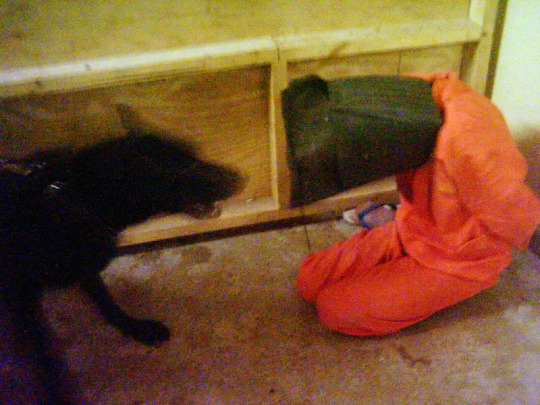
In May 2004, then Secretary of Defense Donald Rumsfeld addressed Congress. The abuse of detainees at Abu Ghraib "was inconsistent with the values of our nation," Rumsfeld said. "It was certainly fundamentally un-American."
Yet the use of attack-trained dogs at Abu Ghraib appears to have been imported from the United States. A 2005 report from the Department of Justice's inspector general scrutinized the private contractors who helped to build and run Abu Ghraib, detailing the backgrounds of the eight corrections experts who selected the site, oversaw the rebuilding of the prison, and trained staff at Abu Ghraib: Lane McCotter, Gary DeLand, Terry Bartlett, Richard Billings, Larry DuBois, John Armstrong, Terry Stewart, and Charles Ryan. Each had been a high-level state prison administrator or corrections commissioner before arriving in Baghdad.
All eight, Insider has found, previously started, expanded, or administered programs at US prisons that authorized the use of dogs to attack and intimidate incarcerated people. McCotter in New Mexico and Utah; DeLand, Billings, and Bartlett in Utah; Ryan and Stewart in Arizona; DuBois in Massachusetts; and Armstrong in Connecticut.
Two decades after the human-rights abuses unfolded at Abu Ghraib, almost all of these state prison systems continue to use unmuzzled attack-trained dogs. Insider has identified 12 states that authorize their use against people in state custody. At least 23 prisons in eight states have deployed attack-trained dogs on prisoners in recent years — Arizona, Connecticut, Delaware, Indiana, Iowa, Massachusetts, New Jersey, and Virginia. Over the past six years, hundreds of incarcerated people have been bitten or mauled.
Human Rights Watch researchers wrote, in 2006, that they were unaware of a single other prison system in the world that used dogs to attack people in the confined space of a cell.
The path to Abu Ghraib
A Department of Justice report named the private contractors hired by the United States as correctional consultants in Iraq. All eight were previously associated with patrol dog programs in US prisons.
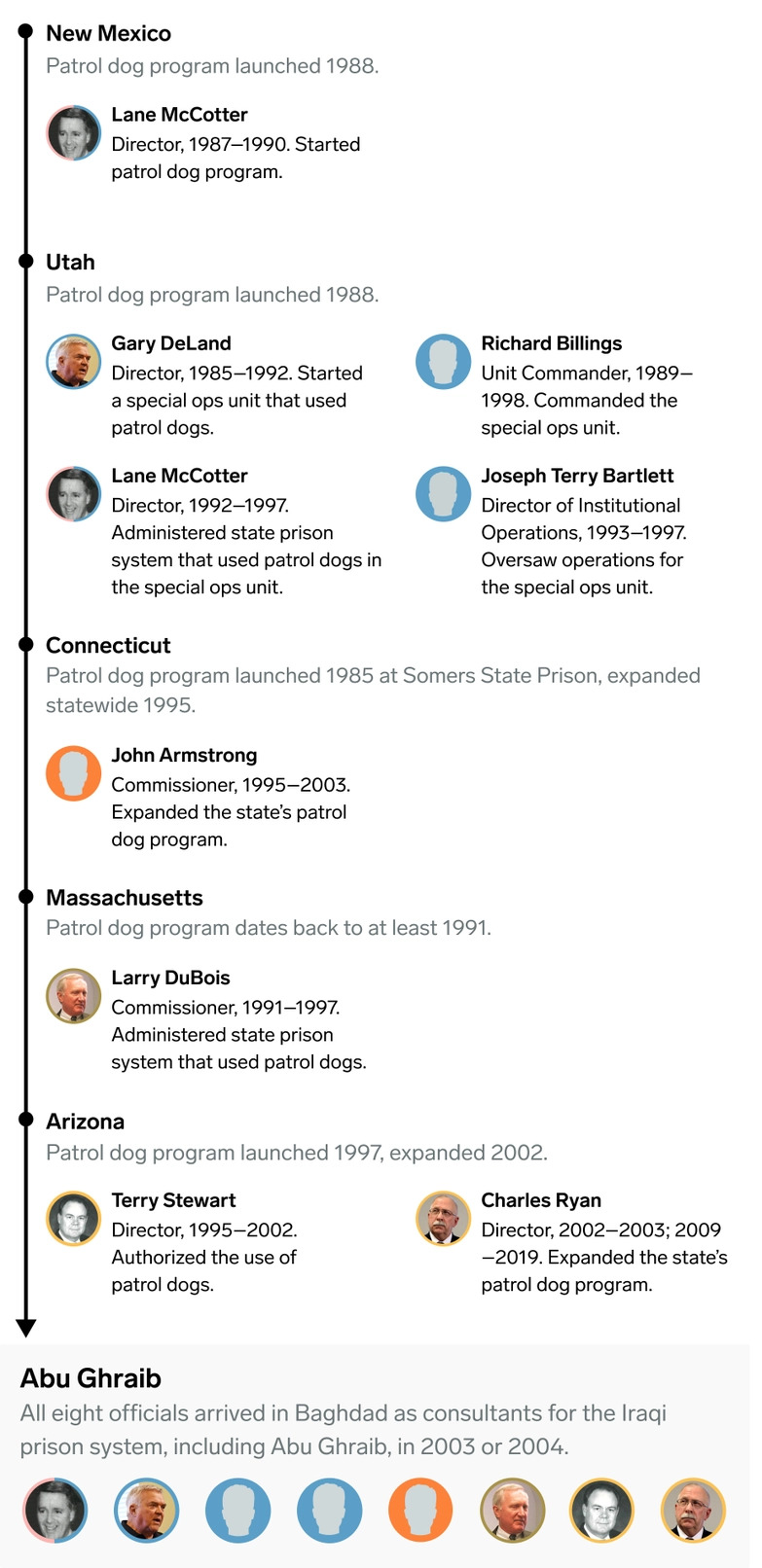
Source: Department of Justice; legislative reports; state departments of correction; news reports.
Alexandria, Virginia
When Adrian Duran was 10 years old, a neighbor at the end of his cul-de-sac in Alexandria, Virginia, gave him a black pit-bull puppy. He cradled him, squirming and warm, under his shirt and carried him home, smuggling him through the back door of his mother's house and down the stairs into the basement where he planned to keep him hidden in the laundry room.
His mother discovered the puppy shortly after and, furious, told Duran he'd have to sleep with the dog in the basement. So Duran curled up on a pile of blankets on the floor and held the puppy's soft, solid weight on his chest as he fell asleep each night. He called him Blackie.

Every day after school, Duran would run home, bolt down the basement stairs, and open the door to the laundry room where Blackie waited for him, yipping in excitement. His mother worked late, so Duran would take Blackie into the streets with him, visiting friends and neighbors and meeting up with older kids in backyards and garages, and on street corners. He tied his blue bandana around the puppy's neck.
Blackie grew into a large, heavily muscled pit bull. When Duran was threatened by other kids, Blackie squared off by his side and growled. Duran bought Blackie a spiked collar and took him everywhere; Blackie became Duran's protector and his most devoted friend.
At around 14, Duran started hustling. He joined a gang and started stealing — first small things, then cars. His mother told Duran that if he got arrested, she would be forced to put Blackie out in the street. Duran loved his dog too much to face that risk. Gutted, he left Blackie with a neighbor who promised to care for him.
Months later, Duran was arrested for driving a stolen car across state lines. In 2008, he pleaded guilty to an assault and got 15 years. By age 18, he'd been transferred to Sussex I State Prison.
There, his relationship to dogs shifted. It felt as if patrol dogs were everywhere, barking and snarling, lunging on their leads just feet away as the men walked between prison buildings. He couldn't escape them. Their near-constant barking echoed and amplified against the concrete and steel of his cell. At 19, he saw one attack a man for the first time. The man's screams nearly obliterated his memories of Blackie.
Duran witnessed 10 more vicious attacks over the next 10 years, experiences so terrifying that he structured his days to avoid the dogs at all costs.
Then he was brutally attacked himself.
The Virginia Department of Corrections
Police departments have long employed trained attack dogs to supplement the range and speed of officers in the field. But prison patrol dogs aren't deployed for chases; they are used inside the prison walls. In these tight, enclosed spaces, the aggressive barking and threat of attack terrorize people trapped inside razor-wire fences and cell doors. The use of dogs to attack people in the confined space of a prison cell has been described by Human Rights Watch as a "well-kept secret" — and a human-rights violation. The dogs' presence inside prisons, the organization found, "is intended to terrify and intimidate."
Even witnessing a dog attack in close quarters is harrowing. One former Virginia corrections officer said watching a dog attack a person, hearing their screams and desperate pleas and seeing all that blood, was a "primal" experience and deeply traumatizing. "It's just not something you forget," he said.
For those who are the intended target of the intimidation, witnessing a dog attack is devastating, multiple men told Insider. Many suffer nightmares, intrusive thoughts, and fear for weeks and months after seeing an attack. For the hundreds of men who are bitten or mauled themselves, the physical and emotional impact can last for years.
Through public-records requests, court documents, medical records, and interviews with dozens of bite victims, Insider documented at least 295 incidents where attack-trained dogs bit incarcerated people over the six years from 2017 to 2022. Insider identified one attack in Connecticut, to break up a fight in 2020; three in Massachusetts, all in the context of forced cell extractions, in 2020; five in Indiana; 15 in Arizona; and 271 attacks in Virginia.
The locations of the bites indicate that many of the men may have been prone when they were attacked; a 2006 study suggested that bites to the head, neck, and torso are more likely when the target is on the ground, hiding, or partially restrained.
Several men described being cuffed or compliant, spread-eagled on the ground, when attacked; one incident report from July 2022 documents that a man in a Virginia facility called Sussex II State Prison was attacked by a patrol dog after he'd been wrestled into leg irons.
The bites are severe, sometimes permanently disabling and disfiguring. Dozens of people said the terror of being attacked by a dog caused them acute distress, such as recurring nightmares or other symptoms of post-traumatic stress disorder. The process of being conditioned to such extreme violence leaves many of the dogs in a state of intense distress themselves. More than one has bitten off his own tail.
State prison systems that employ attack-trained dogs say their use makes facilities safer for those who are incarcerated and those who guard them. Departments argue that the presence of the dogs alone — their barking and snarling — is so intimidating that it deters many violent incidents from taking place. When employed as a use of force, prison administrators say, the dogs replace corrections officers in dangerous situations like breaking up violent fights or forcibly removing a person from their cell, a tactic known as a cell extraction. Yet no studies have established the efficacy of using attack dogs in correctional settings, and records reveal they are deployed differently by each state that uses them.
In Arizona, the department's dogs are trained to search for narcotics and contraband and to attack on command, and they are kept muzzled except when they're being deployed to bite. In Indiana, they're used to detect contraband, but also to patrol perimeters and apprehend escapees. Massachusetts requires wardens to seek permission from the state corrections commissioner every time they bring attack-trained dogs inside a prison facility, and they're approved only for "major disorders" such as cell extractions. In Iowa, patrol dogs are authorized to bite, but over six years from 2016 to 2021, patrol dogs never bit a single prisoner, despite being present at 19 cell extractions, according to records Insider obtained through a public-records request.
The Virginia Department of Corrections is an extreme outlier, commanding dogs to attack on an unmatched scale. Records show that Virginia prisons deploy patrol dogs to attack incarcerated people as a routine use of force in the state's six high-security prisons: Keen Mountain, Sussex I, Sussex II, Wallens Ridge, River North, and Red Onion. Insider documented one additional attack at Augusta, a medium-security facility. In a court filing, the department said roughly one in every seven deployments resulted in attacks. Insider was able to document 271 attacks in Virginia state prisons from 2017 to 2022, through court filings and internal incident reports. Through a legal settlement with the state department of corrections over a public-records request, Insider and the University of Virginia School of Law First Amendment Clinic obtained bite reports for 149 of these attacks.
The severity of the wounds caused by the attacks betrays the tremendous force the dogs can wield. Medical records obtained by Insider contain evidence of deep puncture wounds, lacerations with torn edges, and crush injuries in which muscle, nerves, and bones were damaged from the pressure of the dog's jaw. A study using data from the 1980s and 1990s in Los Angeles found bites from attack-trained dogs were more medically serious than bites from domestic pet dogs. The authors found people bitten by trained law-enforcement dogs were more likely to be hospitalized and require surgeries for skin grafts or tendon and arterial repairs. Dog mouths are also loaded with bacteria. A 1994 dog-bite study found a correlation between the depth of the bite and an increased risk of developing serious infections.
In at least 18 incidents, bite victims in Virginia were wounded so severely by attack-trained dogs that they were transferred to nearby hospitals to be treated for crush injuries, extensive muscle and tissue damage, or septic infections. Others were found to have symptoms of trauma.
A patrol dog named Jerko attacked Jeremy Defour at Sussex II in 2018, biting and tearing his buttocks and genitals, according to court records. The attack went on for a full minute as he lay prone, while he begged for the handler to pull off the dog. He was later diagnosed with PTSD.
Bert, a patrol dog at Wallens Ridge State Prison, bit Antwon Whitten seven times across his back, shoulders, head, face, and hands during a cell extraction in 2015, according to court filings and internal incident reports. Multiple lacerations split his face from the corner of his nostril to his jawline. Healthcare workers stitched his bite wounds with 55 internal and external sutures, according to his medical paperwork.
Bite locations indicate men may have been prone when attacked
An analysis of Virginia patrol dog bites from 2017 to 2022 shows bites to the head, neck, and torso. One study said such bites are more likely when a target is on the ground, hiding, or partially restrained.
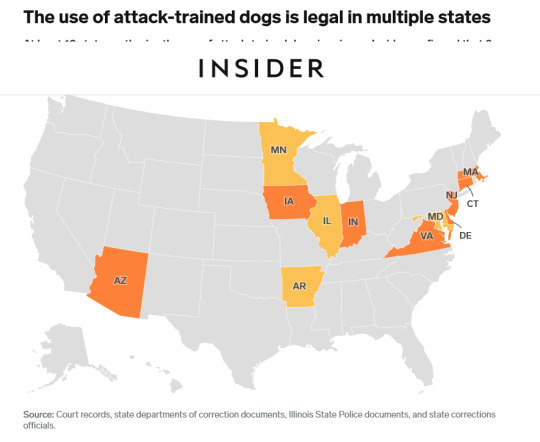
Source: Federal court filings, medical records, Virginia Department of Corrections internal incident reports, "Police and domestic dog bite injuries: What are the differences? What are the implications about police dog use?," Injury Extra, May 2, 2006, by Peter C. Meade, Kern Medical Center.
In response to Insider's findings, a spokesperson for the Arizona Department of Corrections, Rehabilitation, and Reentry said the department was under new leadership and would be reviewing all of its policies and practices, including its use of dogs.
Other departments defended their current protocols. The Indiana Department of Correction said all its dogs were trained "using the appropriate K9 industry standards." The Delaware Department of Correction said department dogs "assist officers in meeting their safety and security mission." A spokesperson for the Virginia Department of Corrections said the department's use of patrol dogs was governed by operation procedures authorized by Virginia law.
Though Insider documented three dog attacks in Massachusetts in 2020, a spokesperson for the state department of corrections said patrol dogs were deployed only to intimidate and "do not engage in use of force tactics." The department, the spokesperson said, "remains committed to de-escalation." New Jersey deployed patrol dogs at least once in recent years, according to court filings — to "restore order" at South Woods State Prison in April 2020. A spokesperson for the New Jersey Department of Corrections said the department's use of patrol dogs conforms to state guidelines on use of force and that no patrol dog had bitten an incarcerated person "in more than a decade."
Departments of corrections in Iowa and Connecticut did not respond to queries.
Tri-State Canines training facility, Warren, Ohio
Virginia Department of Corrections patrol dogs are typically Belgian Malinois, Czech shepherds, or German shepherds. These breeds were once developed for herding but now dominate the ranks of military and law-enforcement canines because they are intelligent, robust, energetic working dogs with a deeply encoded instinct to protect.
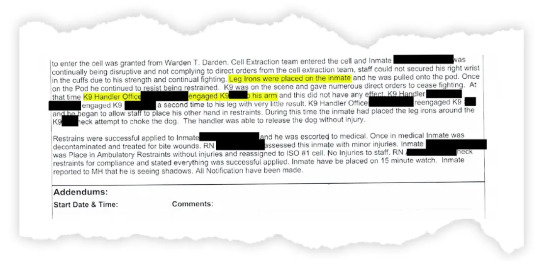
An attack dog's bite is powerful enough to puncture sheet metal. On people, the bites rend skin and muscle. Department patrol dogs are trained to bite once and hold to minimize flesh tears and lacerations. However, in nearly 30% of the bite reports Insider analyzed, Virginia patrol dogs bit more than once or "readjusted" their bites to different body parts in response to a victim fighting or thrashing in pain. The dogs bit arms and legs most commonly but also bit stomachs, faces, hands, feet, hips, shoulders, and genitals. In at least 15 cases over the past six years, Virginia dogs mauled people all over their bodies, biting them three, four, or even six times and leaving wounds on their arms, legs, shoulders, faces, chests, and hands.
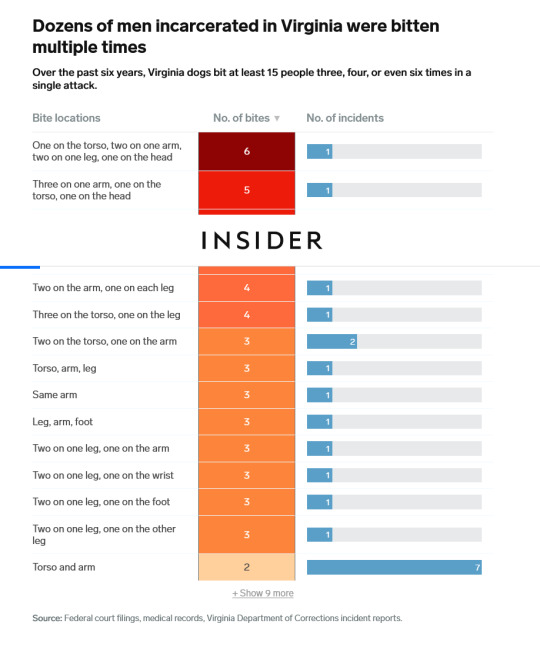
Most attack-trained law-enforcement dogs are bred in central, eastern, and northern Europe where there's a long tradition of training dogs from puppyhood to compete in elite patrol-dog competitions. In these competitions, dogs score points for tracking, obedience, and "protection" — attacking a person in a bite suit on command. The training methods used by some competition hobbyists are notoriously cruel. Videos released by Oikeutta eläimille, a Finnish animal-rights organization, show German trainers beating, kicking, and using electric and prong collars to shock and suffocate their dogs until they yelp in pain.
When these dogs retire from competition, some are sold to American importers like Dave Blosser, the owner of Tri-State Canine Services, a company that sources and trains dogs for US law-enforcement agencies and prison and jail systems. A retired police-dog handler himself, Blosser travels to Europe in search of dogs who possess what trainers call "drive," a potent combination of ferocity, intense energy, desire to work, and aggression.
"We're not looking for Fluffy," Blosser said. "My dog would take down Satan."
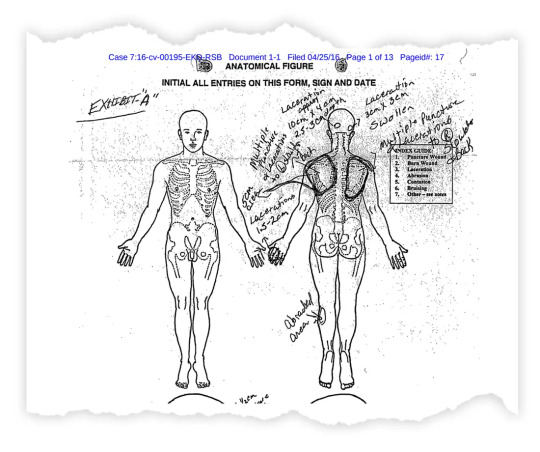
He imports the dogs to his training facility, a converted warehouse in Warren, Ohio. Some of the dogs arrive "hard," too aggressive to handle after getting their "ass kicked over in Holland," Blosser said. He sometimes deprives the most reactive dogs of food and water for a few days. Once they stop fighting him, he begins to train them for their new job: searching for narcotics, chasing a fleeing suspect, or attacking a human being on command.
One day last July, Blosser demonstrated how he conditions a dog to respond to threats with aggression. He led a Belgian Malinois up onto a small plywood table at his training facility and chained him to a metal pole. The handler and other trainers yelled, struck the concrete flooring with cloth bullwhips, and threatened the dog with padded wooden poles until he was defensive and agitated. He barked, a sharp clanging sound that echoed off the cinder-block walls. They continued until the dog was intensely aroused, slavering and chomping. Blosser then approached wearing a padded bite sleeve and pressed the dog's boundaries until he attacked, biting the canvas and jerking his head sharply back and forth.
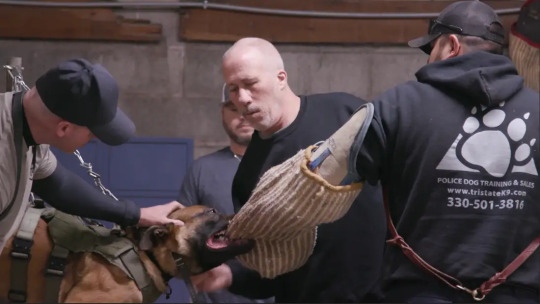
Later that day, Blosser headed to an abandoned elementary school outside Canton, Ohio, where he conducts more advanced training sessions. He sent a volunteer decoy wearing a 35-pound padded bite suit to stand in the corner of a classroom. The suit reeked of sweat and dog mouth, and the dog could smell it from yards away. He panted in anticipation.
As the dog and his handler burst into the classroom, the handler shouted a sharp "stellen" — the German command for bite. The dog lunged forward and up toward the decoy's chest, biting the suit on his arm just above the elbow. The dog held the bite, dragging his weight against the decoy. The man screamed and thrashed to simulate a victim in pain.
These exercises focus on building aggression and confidence, Blosser said. He wants the dogs to "dominate the guy, knock the guy down." Teaching control comes later.
"If you apply too much brake in the beginning, you shut the dog down," he said.
When a dog's senses are flooded with novel stimuli — the smell of fear hormones and real panicked screams — even a well-trained canine might balk and refuse to attack. You won't know how a dog will really react, Blosser said, until he's been "blooded" on a first bite in the field.
Blosser flipped through dozens of photos of dog bites on his phone. Trainers and law-enforcement canine handlers send them to one another, he said, like trading cards. He identifies one woman, her eyes red from crying and arm littered with bite wounds, as a pet-shop assistant who tried to help put a new vest on a police dog. Another shows a canine trainer like himself, his neck gashed open from a dog's tooth that split his skin from throat to ear.
Patrol school, Wallens Ridge State Prison
Matthew Johnson, a former Virginia canine officer at Wallens Ridge, picked out his last patrol-dog partner personally from a purveyor like Blosser in Connecticut, a massive German shepherd with a giant, jug-like head named Oscar. Johnson put his fingers through the metal loops of the kennel fencing and Oscar growled at him immediately. That's the one, he thought.
When Johnson first began training Oscar, the dog whipped around and bit Johnson on the arm, leaving a pair of scars that mangled one of the four horsemen on his forearm tattoo. Stitches still fresh, Johnson returned the next day to work with Oscar, thrilled.
"A dog that'll bite a handler will bite an inmate," he said.
Once Johnson managed to gain control of Oscar, the pair was assigned to Wallens Ridge in 2018. Oscar was a smart dog, Johnson said, and strong — difficult to physically handle. When Oscar would hear "10-18" over the radio, the call sign used to report a fight, he'd race toward the pod doors. He was "hard," Johnson said; he bit with more strength and ferocity than any other dog Johnson had ever handled.
That same year, Boris, a 92-pound German shepherd, went through patrol school and was assigned to his first handler in June at Wallens Ridge. A year earlier, a patrol dog named Cajos was trained, certified, and sent to Sussex I.
A-5 Pod, Red Onion State Prison
In 2017, Duran lay on the top bunk in his cell at Red Onion State Prison.
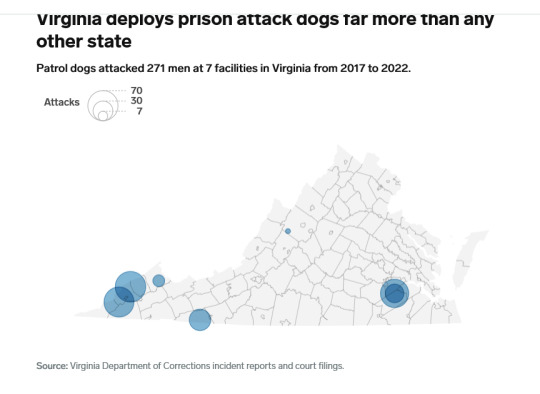
He heard shouts as a fight broke out on the top tier of the 44-cell pod and the quick blasts of officers firing less-lethal rounds. At Red Onion, these are typically "pepper balls" — plastic bullets filled with pepper spray.
Two men ran into Duran's cell and dived onto the floor, as Duran heard the barking of dogs from his upper bunk. An alarm sounded and the cell doors began to slide shut for lockdown. A fourth man scrambled madly at the door, trying to drag his torso through into the cell. He was too late. A patrol dog clamped its teeth around the man's lower leg and dragged him out of the cell, screaming.
Of the 149 bite reports Insider obtained from the Virginia Department of Corrections, there were six reports of bites from 2017 at Red Onion. Only one closely matches the circumstances described by Duran: the March 15, 2017, attack on Linwood Mathias.
The report is spare. "Canine [redacted] engaged offender [redacted] on the lower left leg in the calf area," the handler writes.
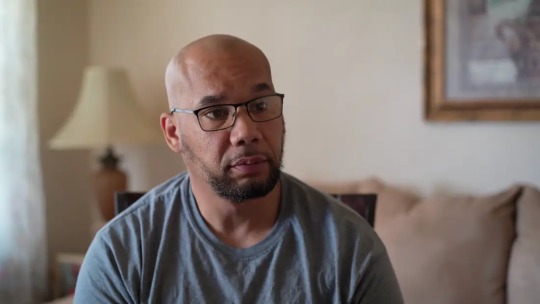
This is what Mathias remembers: being shot at with less-lethal rounds before he dropped to the floor by the cell door, face down, arms outstretched. Feeling teeth like an alligator's bite down on his lower leg. The dog pulling him out of the cell and into the common area, thrashing its head side to side. The dog's teeth tearing into his skin and muscle.
The dog releasing only to bite his calf a second time. His own screams. The moment he stopped screaming and lay still. The way his lower leg looked like ground beef.
Duran likely witnessed all of this more than two years before he was attacked himself.
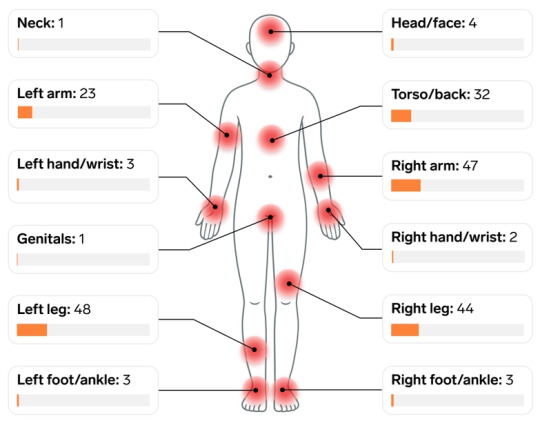
An ambulance took Mathias to Mountain View Regional Hospital in Norton, Virginia, a half-hour drive away from the prison, where he stayed for 13 days. He required 42 stitches and three surgeries over 11 days to clean and debride the wound for infections that left his leg red and swollen from calf to groin.
Mathias first used a wheelchair, then a walker. He spent months in painful physical therapy. But the crush of the bite left his calf muscle permanently frozen. Years later, at his home in Portsmouth, Virginia, he still uses a cane on days when his leg swells and aches with severe nerve pain.
He now lives with intrusive memories that won't let him go. The searing pain of the attack, the revolting feeling of the dog's teeth in his leg. He also can't shake the memory of the canine handler yelling racial slurs as the dog attacked. "Get 'em, boy!" he yelled. "Get that n—."
Later, when he returned to Red Onion
from the hospital, Mathias remembers, another corrections officer said, "I wish I could tie you to my bumper and drag you down the street."
A third officer told him, "We wish you lived out there, so we could shoot you like deer."
'White man's country'
Mathias was one of seven Black men attacked by prison dogs in Virginia prisons from 2011 to 2022 who allege in court filings or in interviews with Insider that corrections officers yelled racial slurs or taunts during or immediately after the attacks.
Xavia Goodwyn said in a civil complaint that a corrections officer used racist epithets as he was being attacked by a dog called Lojzo at Red Onion in 2015. As the canine officer sicced Lojzo on him, he said in an interview, the other officer held him down and repeatedly called him a "n—." Four other Black men attacked by dogs in recent years at Wallens Ridge, River North, and Red Onion said in court filings or in interviews that officers hurled the N-word at them as a patrol dog was biting into their flesh.
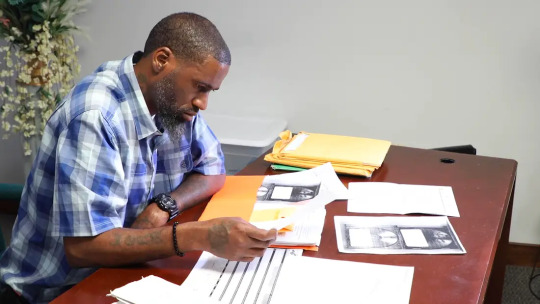
When Michael Watson got into a fight at Red Onion in 2020, he was shot twice with less-lethal rounds before a patrol dog clamped into his back and buttocks for "60 to 90 seconds," according to an affidavit. The handler later visited Watson while he was receiving treatment for his wounds in the prison medical clinic. "My dog got you good," Watson recalled the handler saying as he laughed. "He loves dark meat."
After Thomas Rose was shot with a less-lethal round and blasted with pepper spray after being attacked by another man at River North Correctional Center in 2020, incident reports show, a dog named Tom bit him on his right leg so severely that his shoe filled with blood. As he stumbled toward the medical office, he later alleged in a civil complaint, he heard a mocking taunt from a corrections officer: "Black lives matter."
Corrections officers denied the allegations of racism against Goodwyn and Rose in separate court filings. Officers did not respond to Watson's allegations because he made them in an affidavit supporting another, unsuccessful, civil complaint.
Rose and Goodwyn each lost their cases at bench trials when judges said they had failed to prove that the attacks violated the constitutional protection against "cruel and unusual punishment" enshrined in the Eighth Amendment. The judge in Rose's case found that the officers had issued warnings and that the dog was not used "maliciously or sadistically" — the legal standard required to find an Eighth Amendment violation — "but, rather, in a good faith effort to restore order." In Rose's grievance file, obtained by Insider, the department found "no violation of procedure" in the attack.
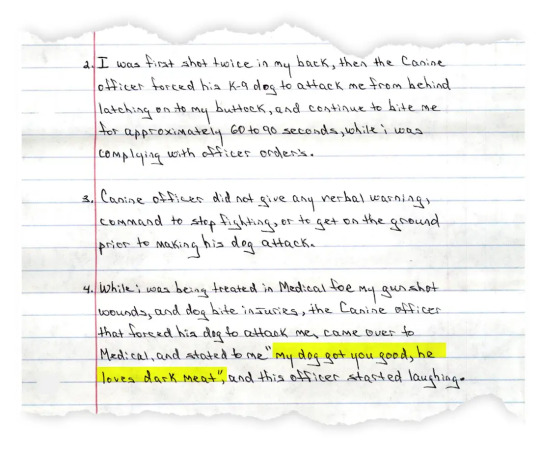
When asked about the allegations of racial violence, Rick White, who has served as warden at Red Onion since 2021, said he was not aware of any situations in which officers had used racist language. The Virginia Department of Corrections did not respond to Insider's questions about individual cases.
Red Onion and Wallens Ridge prisons, in deep rural Virginia near the Kentucky border, have each been repeatedly investigated for allegations of racism by prison staff. Human Rights Watch found in 1999 that Red Onion guards routinely subjected Black prisoners to racial slurs, taunts, and physical threats. In 2000, the FBI opened an investigation into Wallens Ridge after 108 prisoners transferred there from New Mexico filed civil-rights lawsuits alleging they were subject to racist taunts and epithets. One attorney said a guard had threatened to turn prisoners over to the Ku Klux Klan.
Virginia Department of Corrections officials responded to the Human Rights Watch report by calling it "biased and inaccurate." In 2000, Ron Angelone, then director of the Virginia Department of Corrections, called the allegations of racism and excessive force at Wallens Ridge and Red Onion "lies from convicted felons who don't like being locked up in tough prisons."
The following year, in 2001, the Connecticut Commission on Human Rights and Opportunities, a government agency charged with enforcing the state's anti-discrimination laws, also investigated Wallens Ridge, as a number of Connecticut prisoners were contracted to be housed there. The commission's report found that Connecticut prisoners there had been called racist slurs, shot at with rubber bullets, and taunted with songs about lynching.
"Yo, Black boy, you in the wrong place," a prisoner cited in the report recounts a guard saying. "This is white man's country."
Birmingham, Alabama, 1963
Dogs have a long history of being deployed to terrify and attack Black and Indigenous people in the United States. Tyler Parry, an assistant professor of African American and African diaspora studies at the University of Nevada at Las Vegas, and Charlton Yingling, an assistant professor of history at the University of Louisville, study the history of weaponized dogs in the Americas. Attack-trained dogs have helped violently enforce white supremacy, Parry said, from executing indigenous Taino people in the Caribbean, to hunting down those who tried to escape slavery in the American South, to attacking civil-rights protesters in the 1960s.
"The dog has always been intended to strike a certain fear amongst the person that's detained or oppressed," Parry said. He called their use a form of "racialized terror."
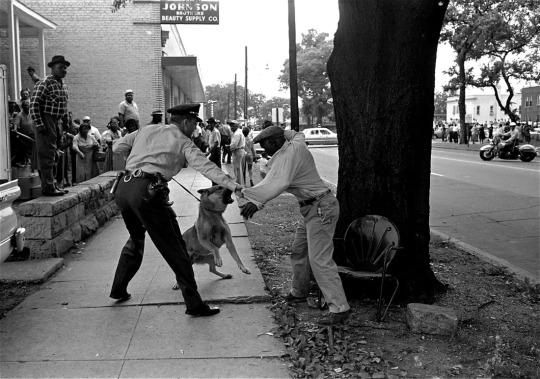
Many slaveholders believed that dogs could sense race, Parry said, that they could be specifically trained to hunt for the scent of Black bodies. Breeders honed these so-called "negro dogs" as manhunters, selecting for sense of smell, strength, tenacity, and aggression to hunt, run down, and sometimes execute people fleeing slavery. By the 1840s, these dogs were commonplace throughout the United States, Parry and Yingling found.
In his 1853 memoir, "Twelve Years a Slave," Solomon Northup describes his pursuit by dogs during an escape attempt. "Each moment I expected they would spring upon my back — expected to feel their long teeth sinking into my flesh," Solomon recounted. "There were so many of them, I knew they would tear me to pieces, that they would worry me, at once, to death."
A century later, in May 1963, when thousands of Black children poured into the streets of Birmingham, Alabama, to join the protests against segregation, the city's notorious police commissioner, Eugene "Bull" Connor, met them with force. He ordered white officers to point fire hoses at the protesters and to sic German shepherds on the young students. In one photo, captured by Bill Hudson, a white police officer grabs Walter Gadsden, a 15-year-old high-school student, as a German shepherd lunges, teeth bared, at Gadsden's torso.
"A hundred years ago they used to put on a white sheet and use a bloodhound against Negroes," Malcolm X said in an interview not long after the protests. "Today they have taken off the white sheet and put on police uniforms and traded in the bloodhounds for police dogs."
After the brutal crackdown on people protesting the killing of Michael Brown by a police officer in Ferguson, Missouri, a half a century later, the Department of Justice investigated the Ferguson Police Department and found a range of civil-rights abuses. These included the excessive use of dogs to attack people, including children, in routine police encounters. In every case where racial information was available, Ferguson police officers had sicced their dogs on Black people.
Officers, the report found, "appear to use canines not to counter a physical threat but to inflict punishment."
Cell 15, P-2 Housing Unit, Souza-Baranowski Correctional Center
There are more than 370 maximum-security prisons in the United States, and the overwhelming majority do not use attack dogs at all.
Yet in Virginia, attack dogs are used, in the words of one corrections department court filing, as a "manpower multiplier" and routinely patrol most areas of the prison. They're a frequent sight in the general population housing units, called pods, that are divided into two 22-cell horseshoes stacked two tiers high; along the concrete pathways, called boulevards, that lead from the residency buildings to the chow hall, classrooms, and visitation rooms; and at the boundaries of the fenced-in recreation yards.
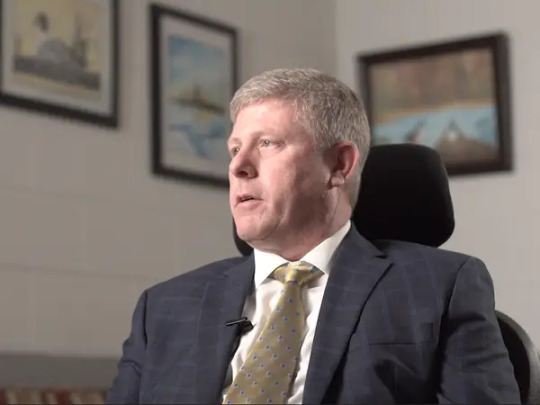
Rick White, the Red Onion warden, told Insider the dogs were primarily used for "presence" — in other words, that the implied violence of their growls and bared teeth is sufficient to frighten people into compliance. He said the canine program has created a safe environment, allowing Red Onion to provide group educational and religious programs. While Insider documented three attacks at Red Onion in 2022, White said dogs were deployed for "presence" more than 200 times that year.
Three former department employees confirmed to Insider that they're used primarily for deterrence. But according to an internal department record submitted in a court filing, dogs were deployed in Virginia to attack prisoners about four times a month, on average, from April 2016 to June 2022. Incident reports record patrol dogs being commanded to attack when prisoners do not immediately comply with orders from corrections officers, when prisoners are fighting, or for cell extractions.
When a man refuses to leave his cell, Virginia canine handlers are authorized to send in their dogs to bite him until he complies. On Christmas Day 2018, in Sussex I, Curtis Garrett ran away from corrections officers breaking up a fight and barricaded himself in his cell. Two dogs, Hurricane and Lojzo, and their handlers were sent in to extract him. In the process, the dogs badly mauled Garrett on his arms and legs, according to a civil complaint. An attorney representing the department later argued to a judge that it was necessary to sic the dogs on Garrett to prevent him from harming himself.

Kathleen Dennehy became a corrections commissioner for the Commonwealth of Massachusetts in 2004, a period when the state allowed the use of attack dogs. Dennehy, who left that post in 2007 and now serves as a corrections consultant, quickly emerged as a critic of the use of attack-trained dogs in prison settings. "A dog going into a cell for the purpose of disarming someone or forcing compliance, to me, is a human-rights violation," she said. "The potential is there to do some serious injury."
Cell extractions are necessary only when someone is threatening to harm themselves or others, Dennehy explained. In those cases, she said, the best evidence-based practice is to deploy a dedicated health worker and a specially trained team of corrections officers who are properly outfitted with body armor, shields, and body cameras to enter the cell and wrestle the person out using as little force as possible.
Dennehy acknowledged that prisons are tinderboxes, and that any small altercation can quickly explode into violence. In these cases, she said, de-escalation is the priority. If force is required, it should be the minimum force necessary — pepper spray, for example — to ensure prisoner and staff safety.
"You don't go into a situation thinking you're going to escalate it and use the maximum force to resolve it quickly," Dennehy said. "The goal is to try to use the minimal amount."
But a dog cannot be trained to bite with the minimum necessary force, Jimmy Stanley, the canine sergeant at Red Onion from 2012 to 2021, said last year in a deposition. Their bites cannot be checked, only directed.
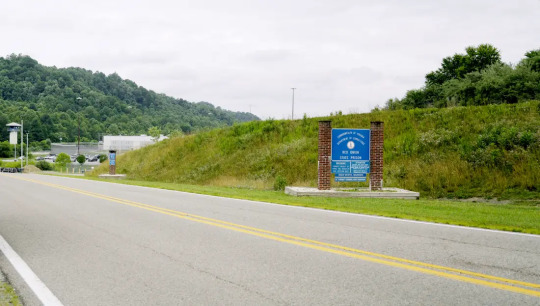
Dora Schriro, the director of the Arizona Department of Corrections, Rehabilitation, and Reentry from 2003 to 2009, discontinued using attack-trained patrol dogs in Arizona prisons in 2006. "The idea that you would have to revert to the dog, particularly one that's trained to attack, is beyond extreme," she said.
Dennehy banned the use of dogs to bite prisoners in Massachusetts state prisons that same year. "I didn't see any instances where we should be sending dogs in to potentially rip flesh off of inmates," she said.
Yet after Schriro and Dennehy left their jobs, both departments reintroduced the use of attack-trained dogs.
In January 2020, over 10 years after dogs were reintroduced in Massachusetts prisons, a patrol dog at Souza-Baranowski Correctional Center called Omar bit Dionisio Paulino during a cell extraction, tearing off a "chunk of his upper thigh," according to a civil complaint and incident reports. In the complaint, Paulino and his cellmate, Robert Silva-Prentice, allege the attack on Paulino was part of a retaliatory campaign in response to an earlier incident in which prisoners had injured three officers. The guards, they allege, used beatings, dogs, Tasers, and pepper spray "to instill a sense of terror and fear of future retaliatory attacks on Black and Latino prisoners."
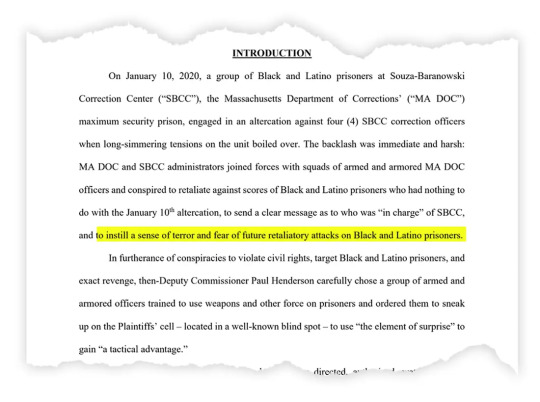
Prison officials said in court filings that the force deployed in January 2020 was necessary to maintain facility security. They also denied that the use of force was retaliatory or excessive. The case is pending.
In May 2023, court filings revealed the existence of a previously secret federal grand jury, which was investigating the bite inflicted on Paulino and other related allegations of brutality and retaliatory violence from prison guards. A federal review of the January 2020 incident could potentially result in federal criminal indictments against state officials for civil-rights violations. If charges are filed, civil-rights attorneys say, it could mark the first time federal criminal charges have been brought over an incident that involved the use of a dog to attack an incarcerated person.
Housing Unit 4, Sussex II State Prison
On September 4, 2019, a fight broke out on the upper tier of Adrian Duran's housing unit at Sussex II, incident reports show. The brawl involved at least a dozen people, including Duran. One of them hit Duran on the head, a blow that split his forehead near his right eyebrow; it bled badly, partially blinding him. In the chaos, he heard corrections officers arriving and fled down the stairs to the lower tier with several other men.
At the foot of the stairs, Duran ran his hands down his torso, checking for stab wounds, and tried to wipe the blood from his eyes. Then he heard a dog bark and a cold fear shot through his chest. A second later, a canine handler and her dog came screaming into the housing unit.
Duran spun and slammed himself chest down onto the floor — his feet toward the door, his head toward the stairs — facing the other prisoners who had also dropped to the floor. He glanced over his shoulder just as Cajos opened his mouth wide.
Cajos bit down on Duran's lower left calf above the ankle. He felt a spike of intense pain as the dog's teeth sank into his flesh, then a brutal pressure as Cajos crushed the muscle and bone of his leg between his jaws. Duran screamed so forcefully that flecks of blood and saliva hit the shocked face of the man on the floor in front of him.
The dog whiplashed his head from side to side. With each jerk, Duran felt his flesh tear in "cracking" splits as if someone powerful were forcing their fingers inside the punctures and ripping the wounds wider. He thrashed in panic and pain.
Duran begged the canine officer to remove her dog. She did briefly, then commanded Cajos to bite Duran a second time. He clamped down on the same leg, just below Duran's knee.
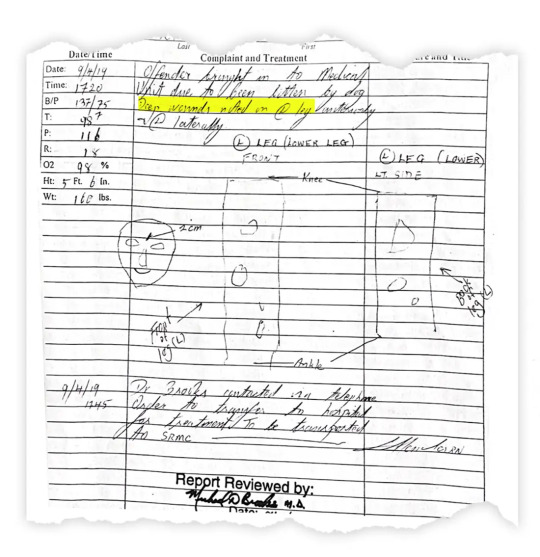
Duran felt detached. He couldn't scream anymore. The other men around him started to yell at the canine officer, desperately appealing to her to release the dog. Duran smelled a sharp metallic scent like copper pennies. It was the smell of his own blood spreading across the floor.
The canine officer pulled on the dog's lead, dragging both Cajos and Adrian backward on the floor until Cajos finally released the bite. Duran lay on the floor in shock, willing himself to lose consciousness. Corrections officers rolled him onto a stretcher and took him to medical where a nurse sent him for emergency treatment.
It wasn't until an emergency-department doctor unwound Duran's bloodied gauze bandages that he saw his own leg for the first time. Puncture wounds the size of nickels with jagged edges covered his lower left leg. Strips of flesh sagged away from his leg where lacerations had sliced through skin, fat, and muscle tissue.
When the doctor bent to examine the wound, she inhaled in shock.
"A dog did this to you?" she asked.
Virginia Commonwealth University Health, Richmond, Virginia
Prison officials sent Duran back to Sussex II less than 12 hours later. Officers pushed him in a wheelchair, following a trail of his own dried blood down the concrete boulevard from the prison exit to the front doors of the residence building, and then straight to a segregation cell.
The cell was filthy, its walls plastered with old food, dirt, and human excrement. Duran lay on the metal bed in dim fluorescent lighting. He tried to keep his wounds protected in the laundered bed sheets. And he wondered whether it would be safe to take a shower, since the water at Sussex II always ran a dull rust brown. Despite Tylenol and Codeine, his leg ached ferociously. He couldn't sleep.
A week and a half later a fever set in. His leg was severely inflamed — swollen, red, and hot to touch. His medical records show that he was prescribed antibiotics, but he said they were never dispensed. A nurse came to check on his fever, Duran said, and immediately ordered him sent for more emergency care. For four days Duran was treated at Virginia Commonwealth University Health for sepsis, a potentially fatal systemic infection, according to his medical paperwork.
Segregated Housing Unit, Red Onion State Prison
After Duran returned for the second time to Sussex II, his life in prison changed. He dropped out of his GED course to avoid passing the dogs barking and lunging in the yard on the way to his classroom. He had intrusive daydreams that the dogs might break their leads and chase him down the boulevard. He woke often in the middle of the night, drenched in sweat.
In one recurring dream, he hits the ground running, the dogs at his heels. He's fast; they're faster. He can't outrun them. At a full sprint he slams into a chain-link fence and tries to haul his weight up and over to safety. Teeth close around his lower left leg. Desperate, he claws at the metal loops, straining against the dog's weight. He can't hold on; his fingers slip. As the dogs rip him off the fence, his body jolts awake.
The dream is now as familiar as the cold fluorescent light of his cell.
Dozens of other incarcerated people bitten by patrol dogs say the attacks severely damaged their mental health. Many suffer from panic attacks, anxiety, nightmares, and depression. Some have been diagnosed with PTSD months and years after the attack, according to psychiatric and mental-health treatment records submitted in court filings.
Antwon Whitten was bitten on his head, face, arm, and shoulder at Wallens Ridge in 2015 by a dog named Bert. He wrote on a mental-health request form submitted in court filings that he was struggling to come to grips with his heavy facial scarring; he was experiencing depression and nightmares. "All day long while awake I can visualize that attack," he wrote.
Curtis Garrett, the man attacked by two dogs in a Sussex I cell extraction, said in a January 2021 court filing that he had suffered relentless nightmares, anxiety, and symptoms of PTSD. He was institutionalized in a state psychiatric hospital, his amended complaint says, for a mental breakdown caused by the trauma of the attack.
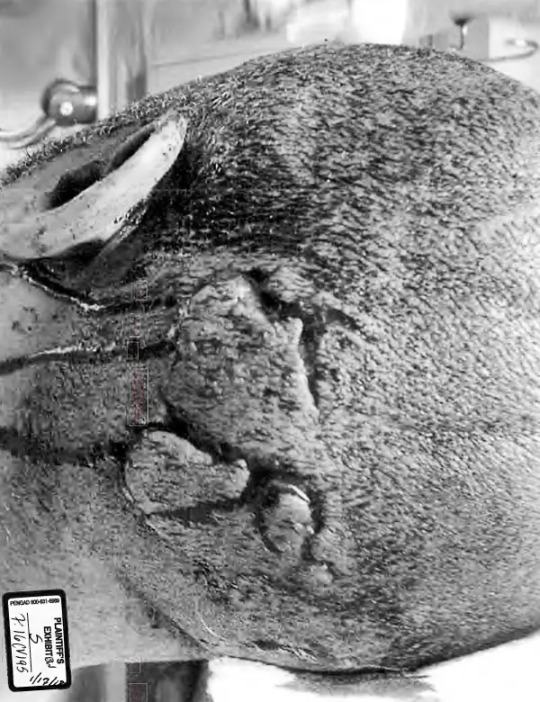
Jeremy Defour had such intense panic attacks and flashbacks after being attacked that he received a formal PTSD diagnosis. He was the one bitten by a patrol dog named Jerko on his buttocks and genitals at Sussex II. During that 2018 incident, he begged the canine officer to remove the dog. Instead, a second handler on the scene brought a barking dog right up to Defour's face, according to a complaint he filed in federal court. "Shut the fuck up," the handler said, "before I let my dog go too."
The emotional fallout from the incident was dramatic. Rather than encounter the dogs in general-population recreation yards and residence pods, Defour chose to spend the next three years in solitary confinement, pacing alone in an 8-foot-by-10-foot cell for 23 hours a day.
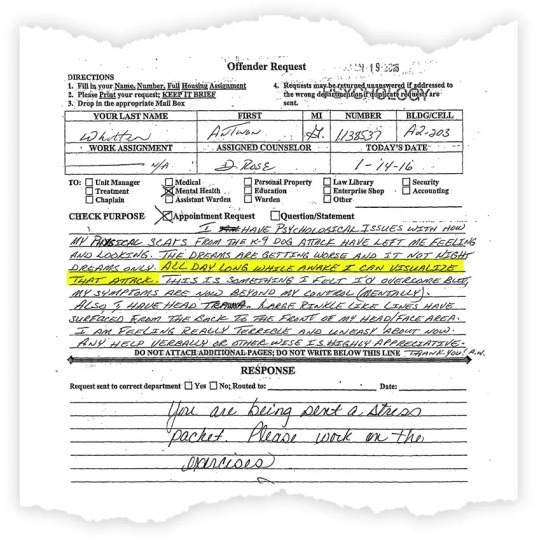
Whitten lost his case when a jury found that the attack was not malicious or sadistic; Garrett and Defour each eventually settled.
Patrol dog kennels, Virginia Department of Corrections
The patrol dog kennels are even smaller, at 6 feet by 10. The dogs run in compulsive circles around their enclosures, beating their tails against the chain-link fencing until they develop raw open sores.
The stress of the repeated attacks eventually breaks many of them.
"It's not natural anymore for a dog to bite a man," said Kenneth Licklider, the owner of Vohne Liche Kennels, in northern Indiana, which sources and trains dogs for law enforcement and for prisons and jails. Licklider, a military veteran, has also trained dogs for the US military, including dozens of explosive-detection dogs used by US troops in Iraq in 2004. He said a trainer must kindle a level of aggression in attack dogs "that went out of them in the stone age."
This requires pressure to a breaking point. Some patrol dogs begin to display compulsive behaviors and become destructive, cracking their own teeth chewing on concrete kennel walls and steel dog bowls. Others will attack themselves.
"This morning I had two canines bite the ends of their tails off," a Virginia canine program administrator wrote in a 2021 email.
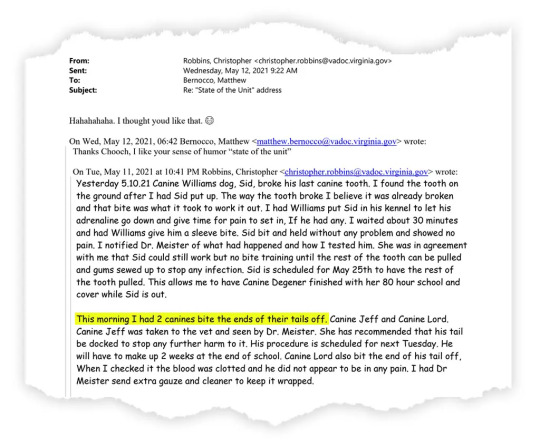
Working dogs like patrol canines that are exposed to prolonged high-stress environments and traumatic violence can become avoidant or hyperreactive, veterinary behaviorists with expertise in canine aggression told Insider.
Incident reports and internal emails contain evidence of prison attack dogs rejecting their brutal assignment. A canine handler reported in 2018 that he tried to force his dog to bite a prisoner three times, but the dog "attempted to back out of his collar trying to get away." Chris Robbins, a Virginia patrol canine sergeant, wrote in a 2021 email that a dog called Rivan had refused to bite someone. He ended up sending Rivan back to patrol canine school to "build his aggression up."
At the Virginia patrol school, trainers build aggression by teaching dogs to "hate everyone but their handler," Matthew Johnson, the former canine officer, told Insider. The dogs cannot be touched, handled, or praised by anyone else.
A veterinary technician who treated patrol dogs at a clinic in Lebanon, Virginia, said she was told not to touch the patrol dogs in her care without their handler present. The technician, who asked not to be named, fearing retaliation, said she'd sometimes sneak a pet on a dog's nose pressed against the kennel door or push treats between the bars.
"They've experienced no kindness," she said. "No kindness whatsoever."
Some dogs become indiscriminately aggressive.
Southwest Virginia Veterinary Services, Lebanon, Virginia
On March 26, 2020, that same vet tech was called into the exam room to assist with a routine checkup for a patrol dog named Boris, a 92-pound German shepherd from Red Onion. Boris was muzzled but was in a state of visible agitation. He was foaming at the mouth and "extremely aggressive" toward the veterinarian and his own handler, Stephen McReynolds, according to an incident report.
McReynolds asked her and the veterinarian to leave the room. Through a slot in the closed door, the technician watched McReynolds pull Boris to the floor in an effort to get him under control as the dog fought to free himself, even trying to bite his handler through the muzzle. Eventually, McReynolds wrapped an arm around the dog's neck and pressed his other hand against the dog's chest. The technician heard Boris cry and struggle, then saw him lie still. McReynolds then called the vet tech and the veterinarian back into the room.
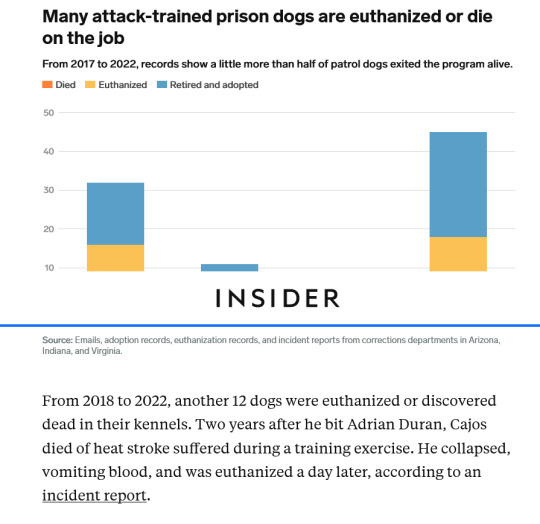
While McReynolds continued to hold Boris in a headlock, the technician said, she started to draw blood from the dog's back leg. Then she noticed Boris begin to urinate. She felt for a pulse and snapped at the handler to release him. Documents show the dog had stopped breathing. The veterinarian started CPR, but Boris was declared dead soon after.
McReynolds did not respond to queries; the Virginia Department of Corrections said it does not comment on personnel matters.
A necropsy report obtained by Insider found that Boris had died of "acute respiratory distress syndrome that resulted in cardiopulmonary arrest." Small purple spots found on the lung tissue included in the report suggested that blood clots had formed in his lungs because of the constriction of his airway, the technician explained.
"I was horrified," she said. "He killed that dog."
A backyard outside Waverly, Virginia
Due to their extreme reactivity, Virginia patrol dogs who are no longer suitable for work can be adopted only by a former handler, by department policy. This is their sole path to retirement.
Daniel Clinton, a former Virginia canine handler, adopted two of his former dog partners: first Tom, then Riko. Clinton kept the dogs in kennels in his backyard outside Waverly, Virginia, to give them time to decompress. He played with them outside with basketballs they'd pop between their curved teeth and let his kids carefully feed them kibble to teach him to trust them. Eventually, Tom became so docile, he said, "so ready to be loved, to be a pet," that he got to come inside. (Insider could not confirm whether he is the same Tom who bit Thomas Rose.) He would lay down on the living-room floor and delicately eat potato chips fed to him by Clinton's 6-year-old daughter.
Other adoptions are a struggle. Johnson, the former Virginia canine officer, adopted Fuga, a German-shepherd mix who was retired after he broke all four canine teeth on bites. Fuga remained so aggressive, Johnson said, that he had to keep the dog in a kennel in his backyard, surrounded by a 6-foot-high fence. If Fuga escaped, "the first thing he might do is bite a kid," Johnson said.
Some dogs are too dangerous to ever be adopted. In Virginia, four dogs were euthanized for aggression, destructive behavior, or liability risk in 2021 alone. The following year, another dog was euthanized after severely biting handlers at Wallens Ridge, Sussex I, and River North, according to an internal email and incident reports.
"I have tried to put him in a muzzle several times to work with him but it is nearly impossible," Chris Robbins, the Virginia patrol canine sergeant, wrote in an email on May 2, 2022. "We are going to keep having these issues," he wrote, "if we keep trying to rehabilitate him." The dog was euthanized three days later.
From 2018 to 2022, another 12 dogs were euthanized or discovered dead in their kennels. Two years after he bit Adrian Duran, Cajos died of heat stroke suffered during a training exercise. He collapsed, vomiting blood, and was euthanized a day later, according to an incident report.
Exterior, Red Onion State Prison
In the last year of his sentence, Duran, now 33, began to cautiously imagine his life outside.
He got married in January to Jamie Elliott, a former nurse at Sussex II. Elliott and Duran had gotten to know each other when she did medical calls on his pod; she quit her job in June 2021 when she realized she and Duran had feelings for each other. Like Duran, Elliott was scared of the patrol dogs, who often lunged and snapped at her, straining at their leads as she walked the boulevard between prison buildings. They felt to her like a constant reminder of how punitive and intimidating the prison was.
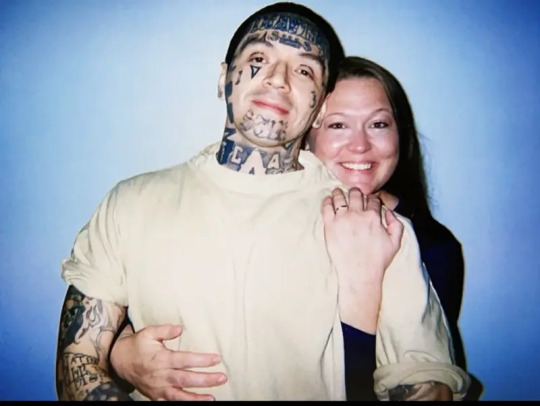
The couple wed in the Red Onion visitation room in front of the guard booth. Duran couldn't stop smiling. In their wedding photo, the two of them are posed against the blue wall of the prison's visitation room. Elliott loops her arms around him and hugs him close. Now they talk on the phone every day, about their families, Elliott's new nursing job, and ordinary details of her daily life outside. Occasionally they squabble over whether Duran will be able to tolerate the presence of Bodhi, Elliott's 12-year-old chihuahua, when he comes home to her.
Some days his future feels guaranteed. Elliott sends him pictures of the flowering crabapple trees in front of the exit doors of Red Onion, and he imagines walking past them the day he leaves. He imagines taking long walks in the mountains with no one else around. He imagines meeting his new nephew before the baby learns to walk.
Other days his leg aches, and when Jamie asks about his day he has nothing to say that won't frighten her.
Like the day last spring when Duran was in his cell on the top tier right at the moment Jawan Lee was returned to the pod from another residence hall. Boisterous and funny, with a quick smile and expressive hands, Lee took a spin around to greet everyone before walking up to his own top-tier cell, right by the stairs.
A group of corrections officers arrived with the lunch cart, according to a grievance document later filed by Lee, and began to release the men in clusters to retrieve their trays. Just as Lee walked out onto the stairs, another man ran out from an unsecured bottom tier cell and tackled him, pinning him on his back.
Lee fought back. A corrections officer sprayed Lee directly in the eyes and mouth with pepper spray. From his top tier cell, according to an affidavit he filed later, Duran watched a handler pull a patrol dog up onto its hind legs and drop it, bodily, on top of Lee. The dog bit into his lower right leg. Lee screamed.
The dog shook Lee's leg like a rag doll. Duran, watching, broke out into a cold sweat. His stomach knotted. The dog pulled backward on Lee's leg, tearing the muscle. Duran had to turn away. He doubled over on the corner of his bed near the wall and tried not to listen to Lee's screams.
Later, Lee would tell Duran that when the nurses unwound the gauze around his leg he saw a chunk of flesh missing from his calf like "a half a tangerine."
Lee remembered the nurse pointing to the wound. "I can see your bone," she said.
#Patrol dogs are terrorizing and mauling prisoners inside the United States#k9#k9 units#dogs weaponized
3 notes
·
View notes